Ireland part 2
More adventures.
Thursday July 9
I took it easy this morning because of my knee. My roommates were up early, packing their things and apparently heading out. I wouldn’t miss them; the New York girls were particularly unsocial (living up to the stereotype I guess?). I had a leisurely breakfast, then headed out at 9:45, to the bus service office thing on O’Connell Street. Along the way, I passed the Post Office, where the Easter Rising had taken place. A lovely building, still in use. They also had a stamp museum but I decided to skip that. :p
The bus service was a little further down the street. It turns out they have a chip card system similar to the Oyster card in London, except it’s called a Leap card here. It’s green and has a frog for a logo, surprisingly. ;) It’s valid for 5 years, so if I manage to get back to Dublin in the next five years I should remember to bring it with me! I put ten euros on it, then headed to the bus stop to take the bus to Merrion Square.
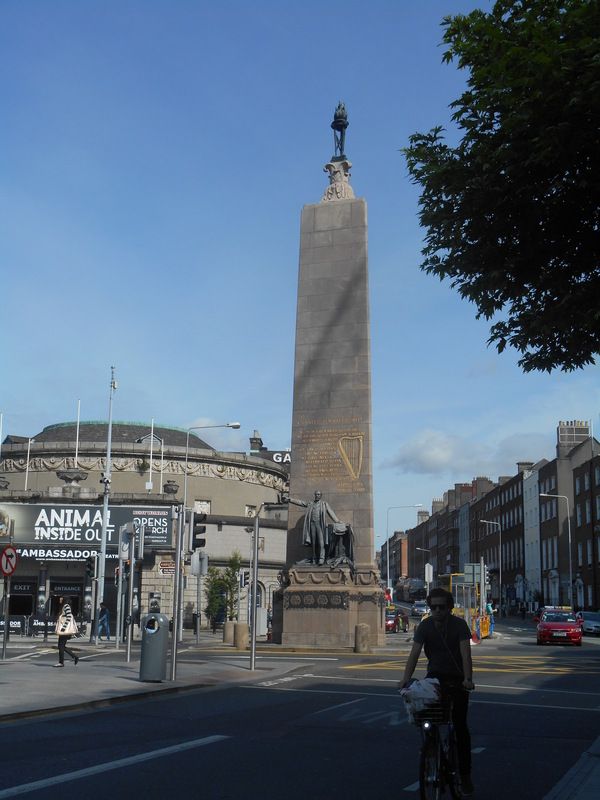
The monument for Daniel O'Connell on top of O'Connell Street, near the bus stop.
I didn’t have long to wait. I got on the bus, passed my card over the scanner and sat down. An old lady sat down next to me. As I observed the other passengers, I noticed that nobody was passing their card past the scanner as they got off... so I asked the lady if I needed to check out with my new Leap card?
Turned out she travelled for free since she was a senior, so she had no idea, but we did have a fun conversations about where I was from (she complimented me on my English), where I was going, what my plans were, what a shame it is the Irish speak only one and a half languages (English and a little Irish), etc. Halfway through our conversation we were joined by a Dutch lady at the other side of the aisle, who explained the Leap card system to me. Turns out that you don’t check out - in fact, you don’t even really check in. You tell the bus driver where you want to go, and he passes the card past a scanner so the right amount of money is written off. If you use the scanner yourself, you write off too much for most destinations in Dublin. Is it just me or is that a really complicated system?? Oh well.
I kept chatting with the old lady until I reached my destination (turned out she had been to America and Australia as well, and was really pleased to hear I would be going to Galway and Inishmore as that was the ‘real’ Ireland) and got off, wishing the old lady a nice day. It turned out the bus stop was right in front of Oscar Wilde’s childhood home!
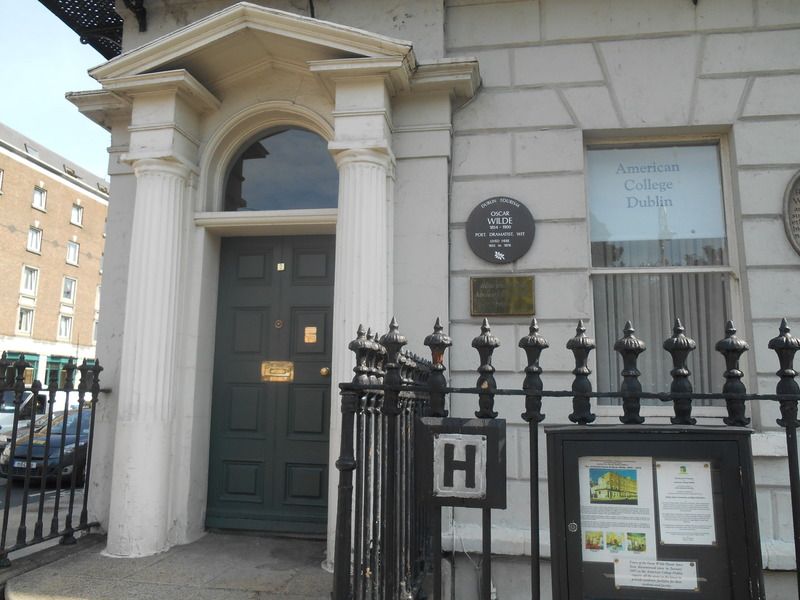
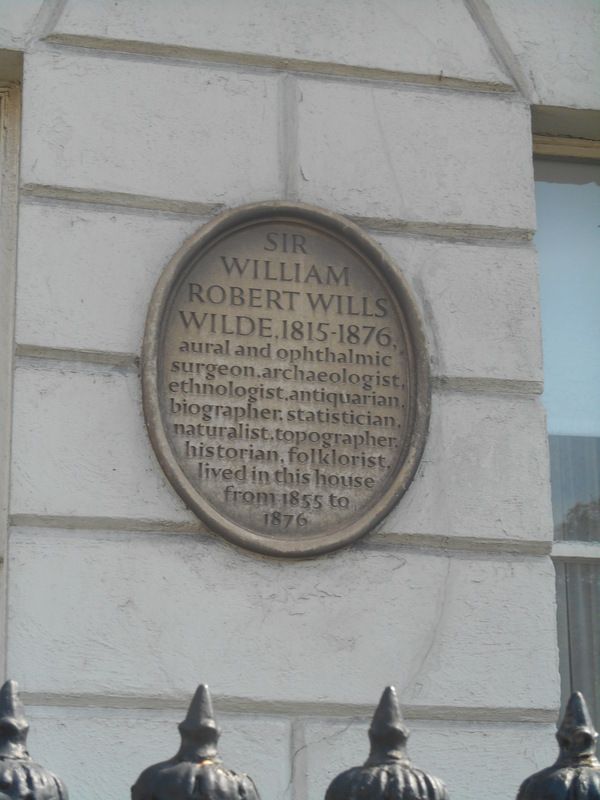
Right opposite that, in Merrion Square Park, was the famous statue, the Fag on the Craig (thanks, Dubliners). I had lunch there, in the morning sun with a view of Oscar. They had pillars with some of his quotes next to the statue so I spend a few amusing minutes reading them all.
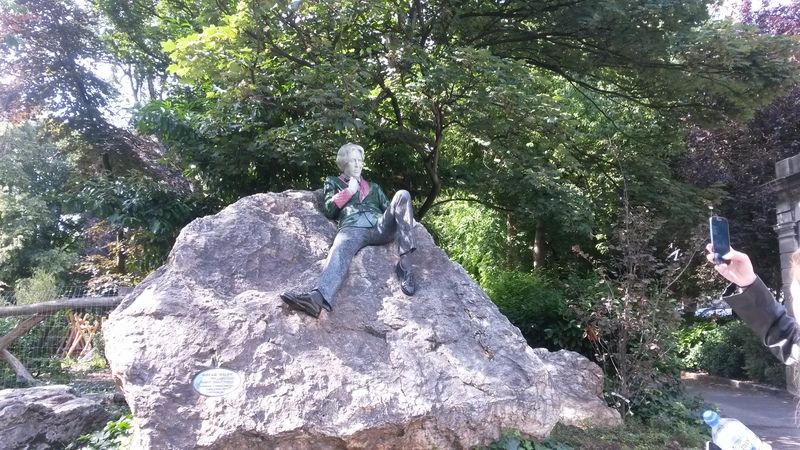
Is it me or is he kind of leering at everyone?
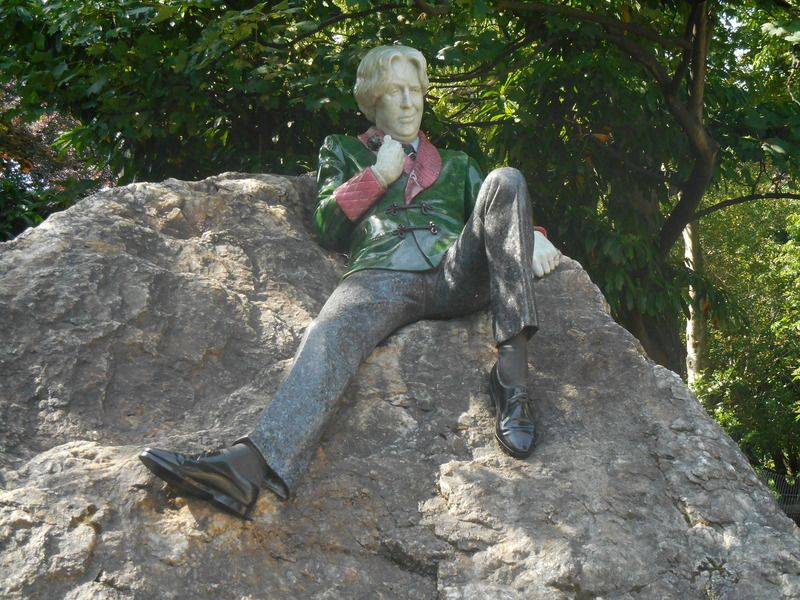
[insert witty bon-mot here]
Lovely park though.
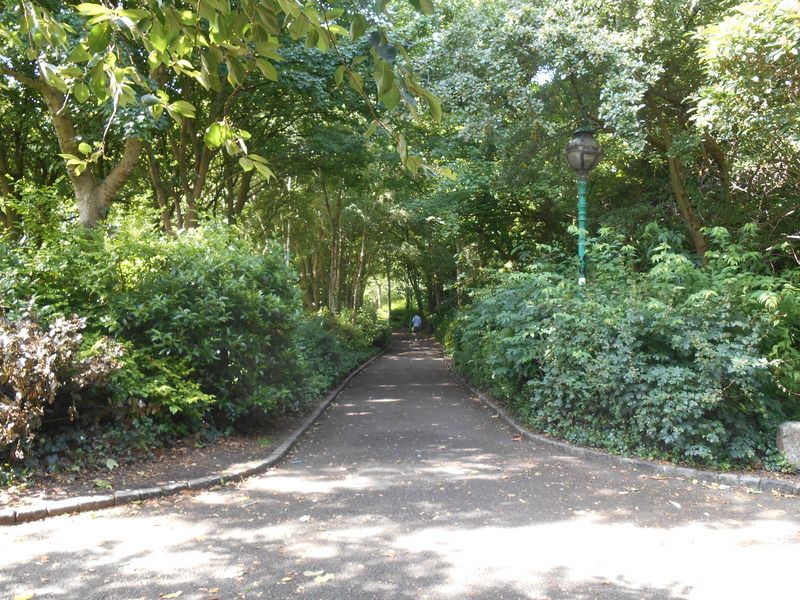
Albeit with some disturbing statues:
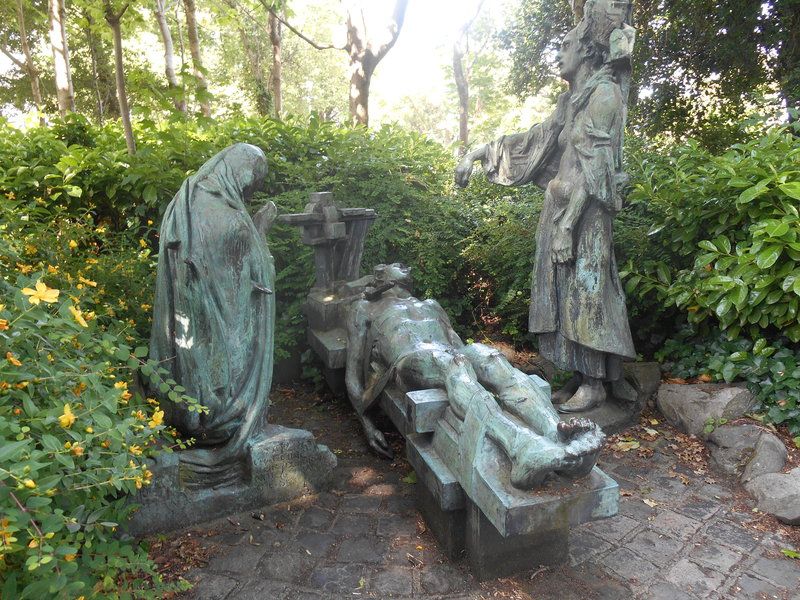
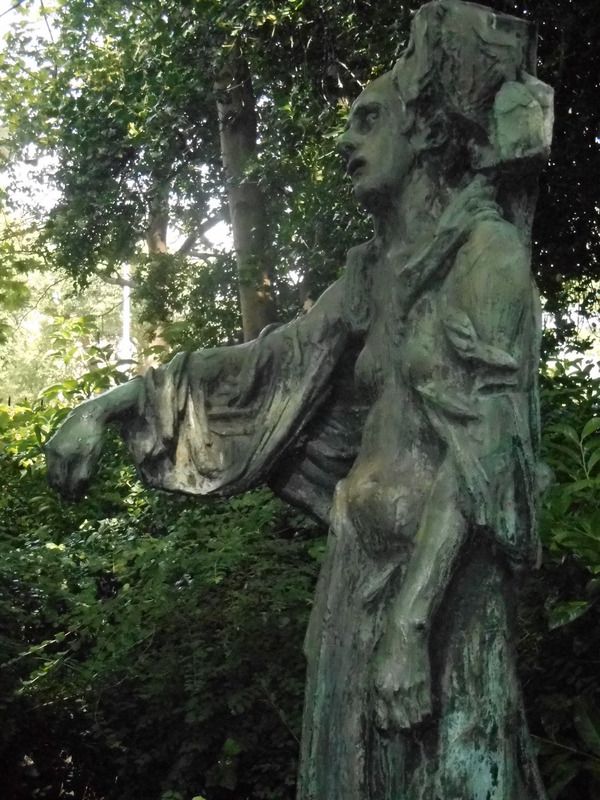
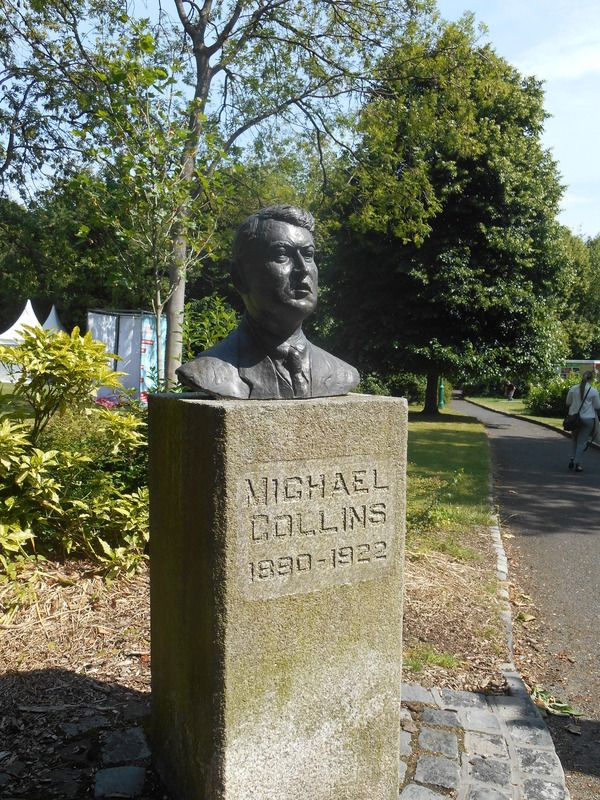
Michael Collins, looking more like Louis van Gaal than Liam Neeson.
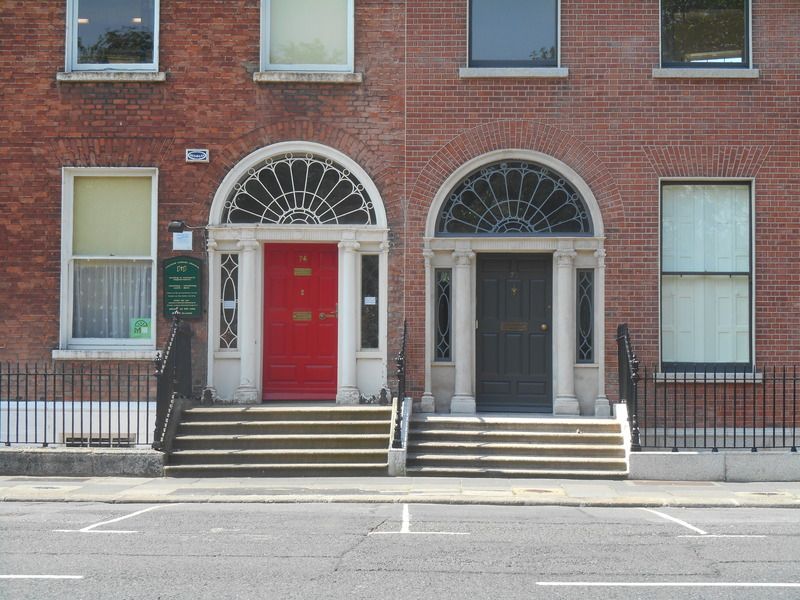
Merrion Square is surrounded by row houses, which all look very similar. Of course, the people living here didn't want their house to look exactly the same as their neighbours', so every house had a different front door! This picture looks photoshopped but it really wasn't. :p
After my lunch, I walked through the park (nice and quiet, very peaceful) to Number 29, a museum about Regency-era Dublin. I couldn’t find it at first, but it turned out I was looking with my nose as there was a huge sign outside. Oops. Entrance was through the servants’ entrance, downstairs.
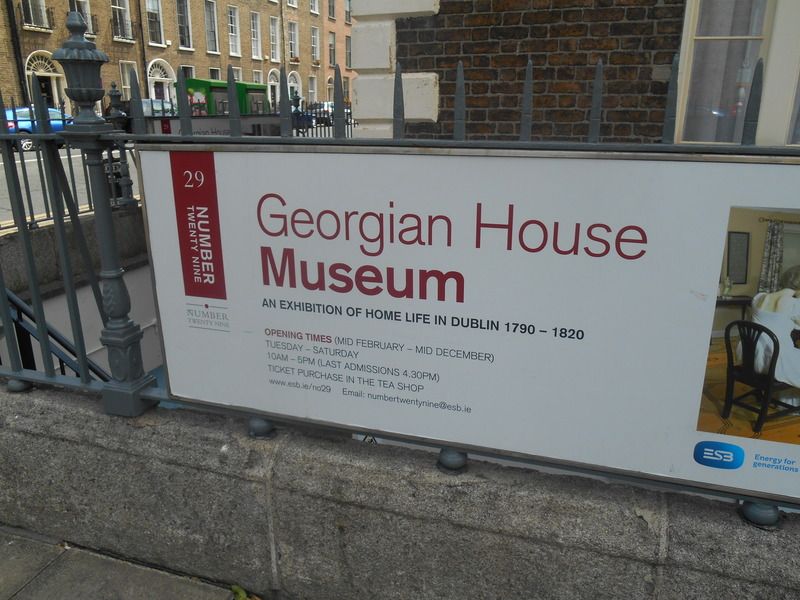
"Hmm I wonder where the museum is?"
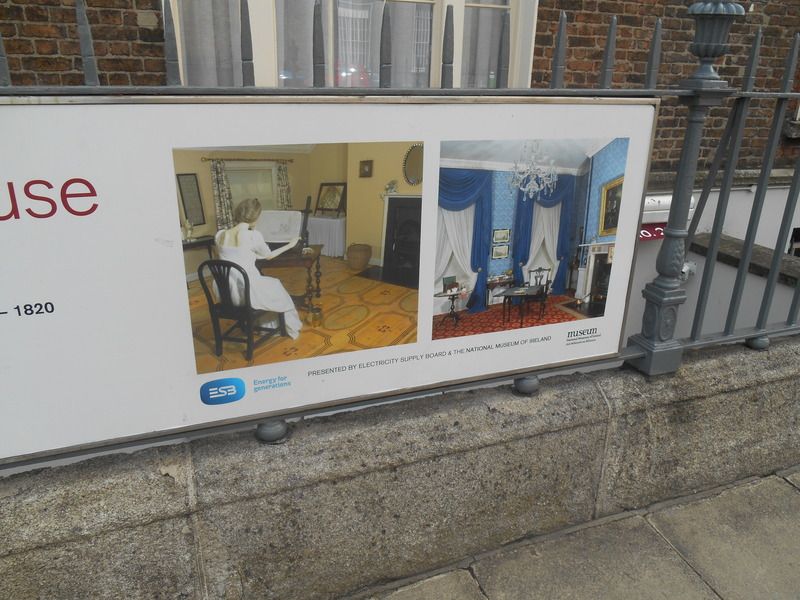
It was a really fun museum. The house used to be owned by a Mrs Beatty and her 7 children, in the early 1800s. It has been restored to what it had been like back then, from the kitchen and scullery to the nursery up top. Really interesting, especially if you are interested in Jane Austen! Especially amusing to see how the kitchen downstairs was very sober and utilitarian, then the first floor with the salon was very beautiful and ornate, the bedroom above that slightly less so, and the nursery up top very bare with second-hand furniture. No visitors ever got there so why would they need to decorate that? Even the carpet on the staircase got shabbier as you went upstairs. :p I especially liked the nursery, to see how education was handled at that time.
Sadly, I wasn’t allowed to take pictures. I did spend some time talking to one of the guides there, about the Anglo-Irish, where Mrs Beatty would have send her children to school (boarding school naturally), and the role of Catholic people in Irish society at that time. She also mentioned that my English was so good. Yes, I know. :p
I headed out again, to go to the National Museum of Archaeology. According to my map, it should have been relatively easy to find. Of course, in real life, that doesn’t always follow! As I was studying my map, trying to figure out which of the many narrow streets was the easiest way to get there, I was approached by an older gentleman: did I need any help?
Me: “I’m looking for the National Museum.” *shows map*
Him: “ohh I have no idea how to get there... But where are you from?”
Me: “the Netherlands.”
Him: “your English is very good!”
I knoooooow, hahaha. Cue a long conversation (well, mostly a monologue from his side) about what a shame it is that so few Irish people really speak Irish fluently, he barely knew any either, it was all because of ‘the Brits’, did I know what he meant by that, such a shame, oh where was I going, oh the museum, no he didn’t know how to get there, but he’d heard it was really interesting, was I staying in Ireland long, where was I going after this, did I know any Irish, oh “cáed mile fáilte”, very good, very good. Etcetera, etcetera. :p
After about fifteen minutes or so, when he still hadn’t been able to tell me how to get to the museum but I did get a quick lesson on the history of the oppression of the Irish language, we said goodbye. I’d asked him what “hello” was in Irish, he didn’t know, but he did know “goodbye”, which was “slán leat!” So we said goodbye in Irish. :-)
I followed the route he thought was probably the most likely to lead to the museum, and wandered around some more. It had turned quite warm by then, which makes being lost quite annoying.
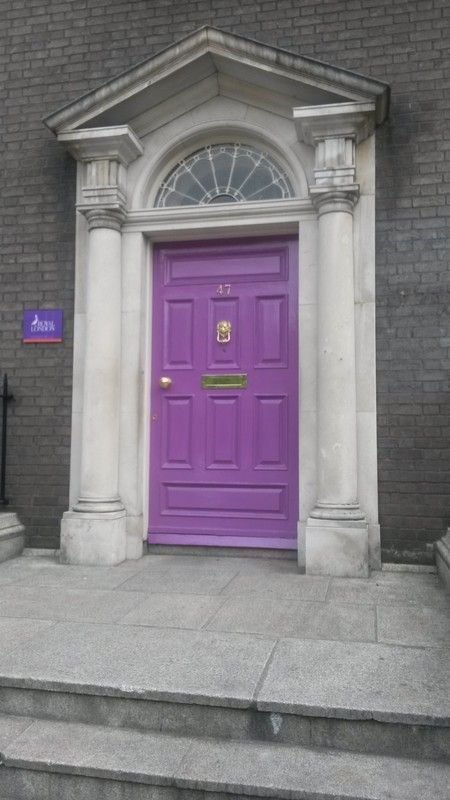
That's one way to make your house easy to recognise.
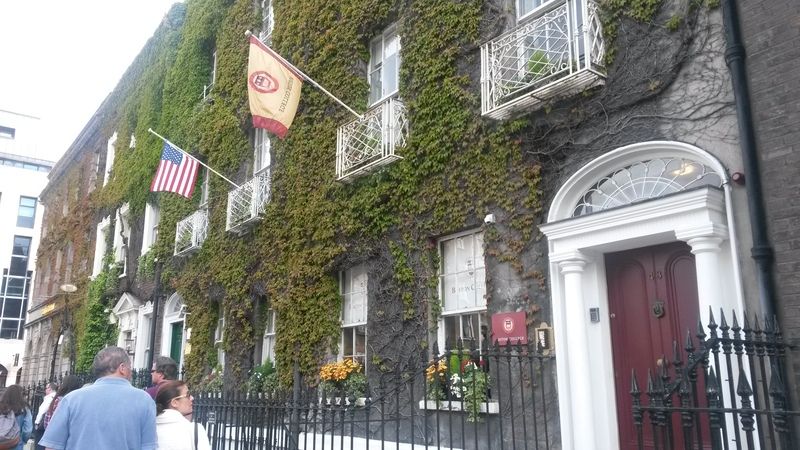
Eventually, after some wandering, I found St Stephen’s Green (it’s not really hard to miss, really), Dublin’s central city park, which is close to the museum. After a little more searching (they might make the signposts a little easier to find...), I even found the entrance! Yay. :p
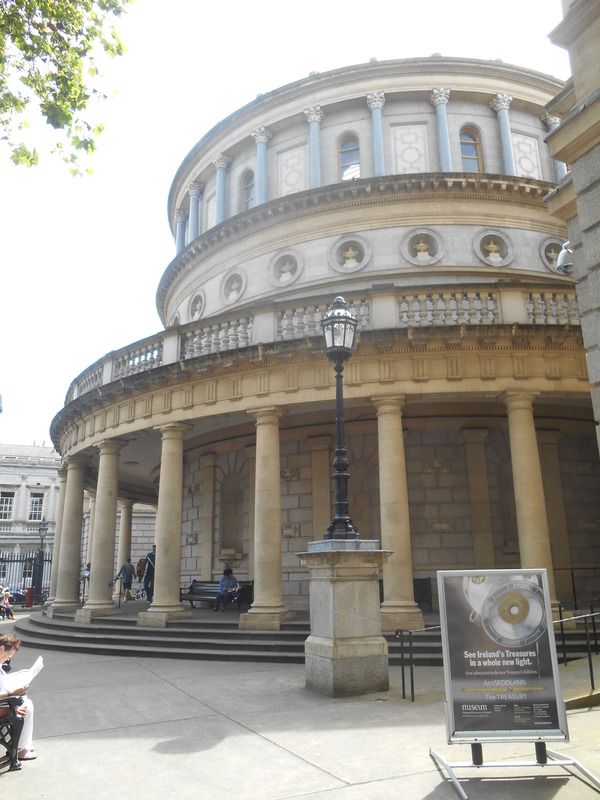
Like all large museums in Ireland, the museum was free! I did head for the café first thing because I was parched after walking in the sun for so long, and my Wilde lunch had been a while ago. While in the café I also discovered that my coat fit in my backpack, which is very convenient, haha.
Astonishingly enough, this museum was all about... archaeology! Ireland has of course a very rich history, so they had large exhibits about all kinds of stuff they had dug up from the peat bogs. Even one entirely about gold, which was apparently plentiful in Ireland.
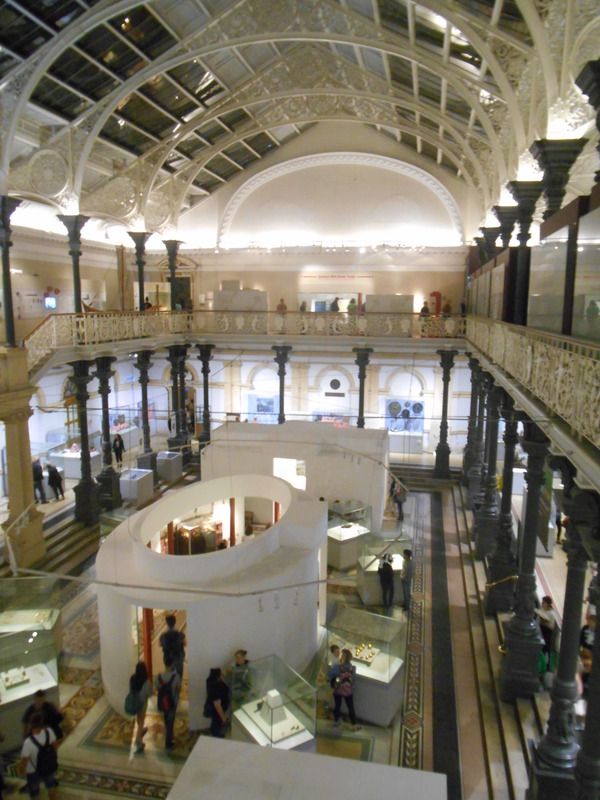
The central hall with the Irish gold exhibition.
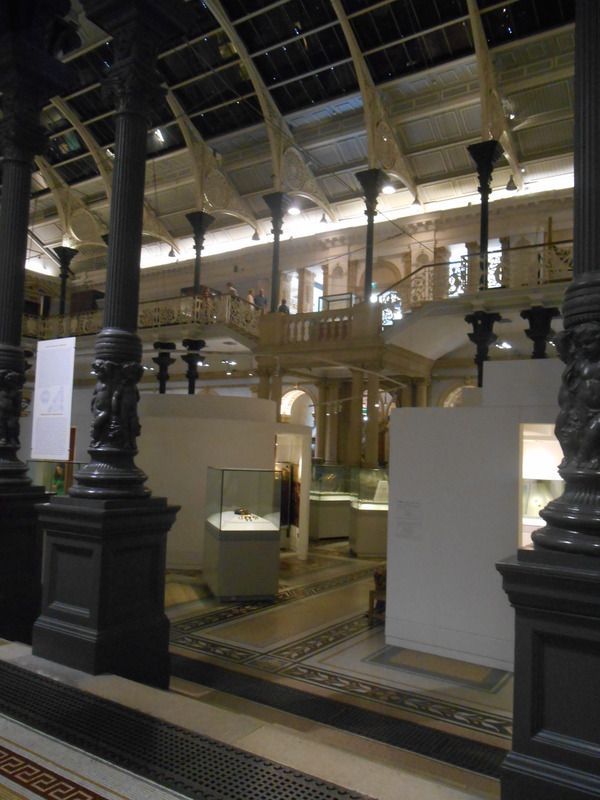
It was really interesting and neat to see in real life. Especially the ‘real Irish’ things were beautiful, and it was amazing to think that some of these things were a few thousand years old. Some person had spend ages crafting the most delicate thing, and here I was centuries, even millennia later, looking at it.
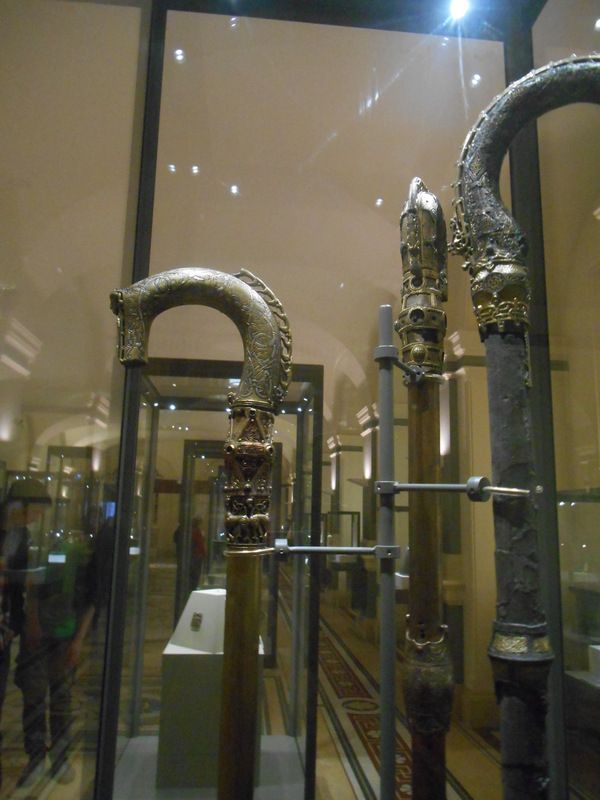
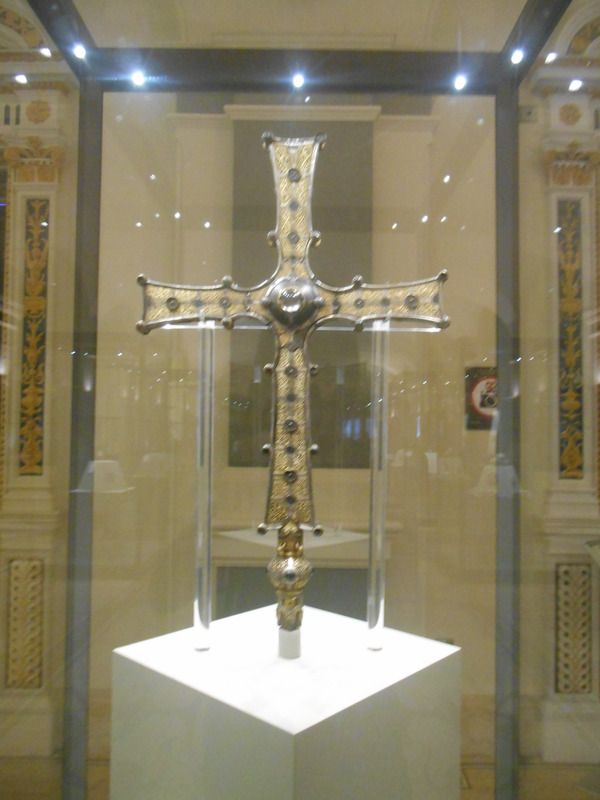
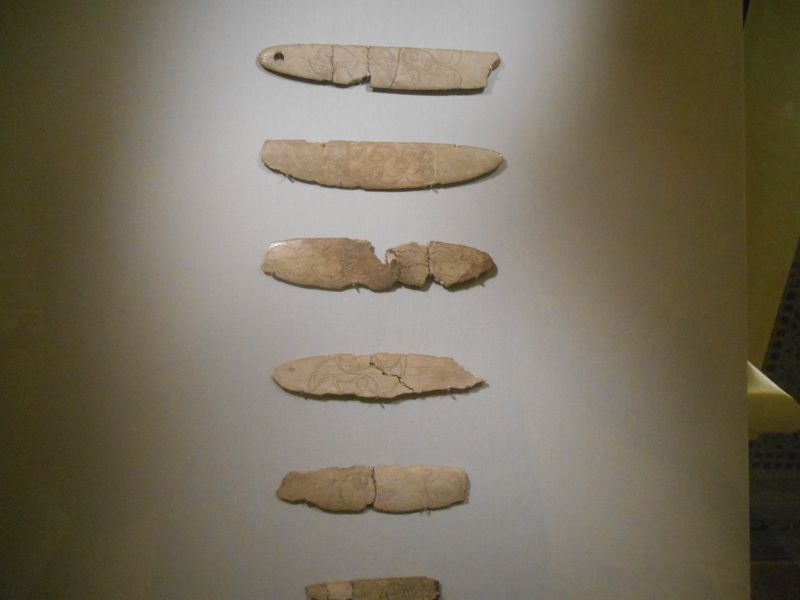
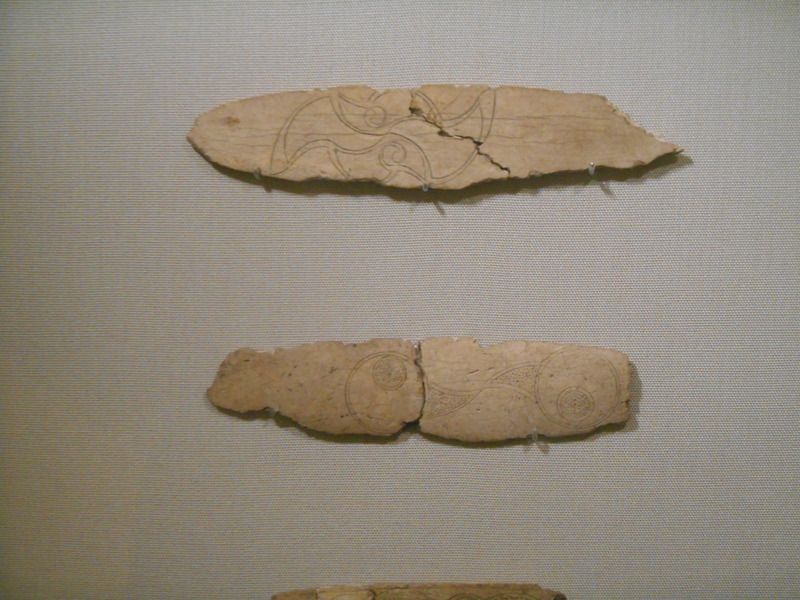
This looked almost Gallifreyan...
They also had an exhibit about bog bodies. Ireland has large peat bogs. The bogs have highly acidic water, low temperature and no oxygen, so the bodies put in the bogs are naturally mummified. Because of the nature of their mummification, the skin doesn’t get dissolved but gets tanned like leather, leaving the bodies well preserved. Most people found in the bogs were probably human sacrifices, judging by the nature of their wounds.
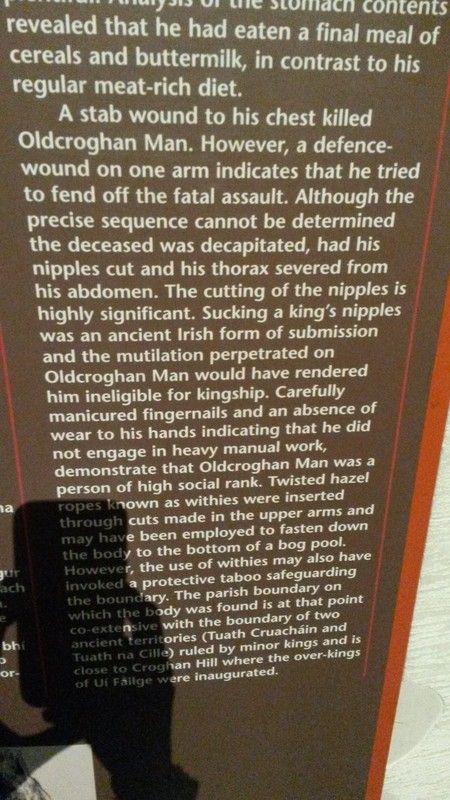
They got really creative with them, too.
Honestly, this exhibit was mostly just sad. With mummies, you know it’s a dead person in there, but it doesn’t really look like a recognisable person because of all the wrappings. A bog body, on the other hand, really does look like a person, albeit sometimes a deflated one. :p But you can still make out the hair, the fingernails, stuff like that. You really get a sense of “this was once a person just like me, and now they’re dead and I’m looking at the corpse in a museum.”
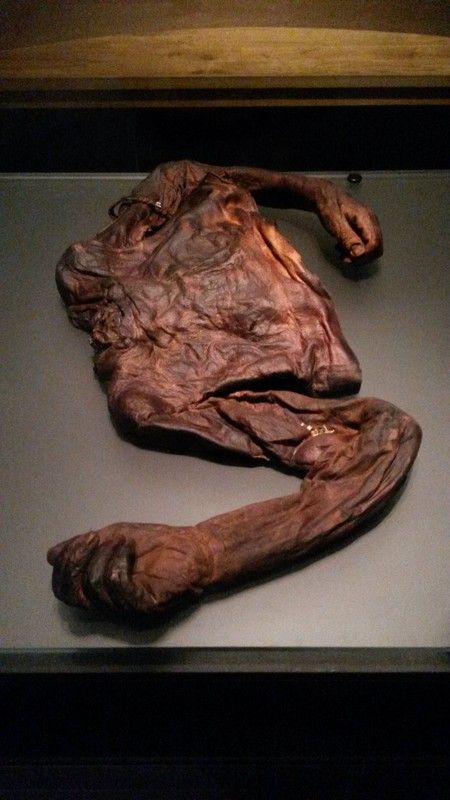
It also didn’t help that there were groups of teens running amok in the museum, who thought the bog bodies hilarious... The museum was overall overrun by barbarians, including a woman who actually touched an Egyptian statue. Was she raised by wolves??
There was also a bit about excavations at the Hill of Tara, which was especially interesting since I would be visiting it the next day! They had a scale model and everything. The two circles (labeled 1, 3 and 5) are most important parts, the Mount of the Hostages and the Stone of Destiny.
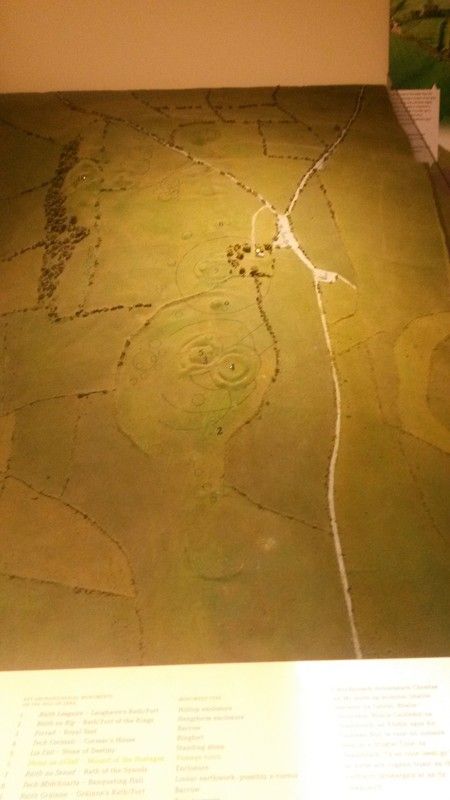
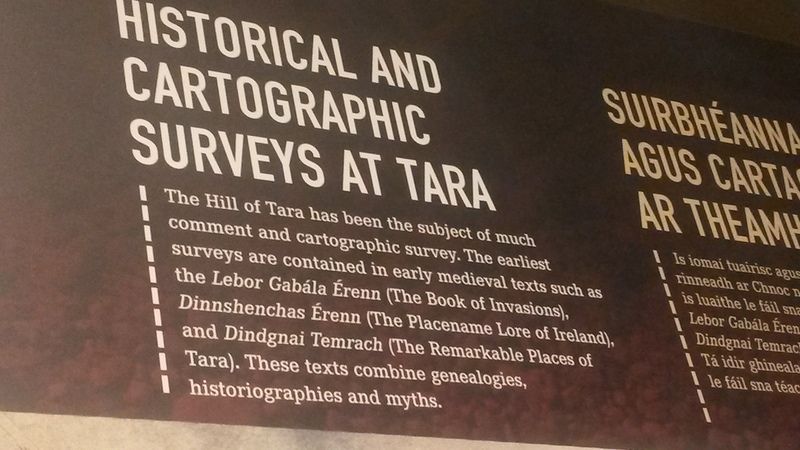
And this really amused me since the Lebor Gabála Érenn also appears in a D&D game my friends and I are playing!
I spend about an hour in the museum - it’s not that big, and most of the medieval and Egyptian stuff was pretty similar to things I’d seen in the British Museum, the Louvre and Leiden (yep, I’m museum blasé). So I headed out again. Since it was a beautiful day, I walked over to St Stephen’s Green. It’s a large park, right in the centre of Dublin. Grafton Street actually ends right at the entrance to St Stephen’s Green!
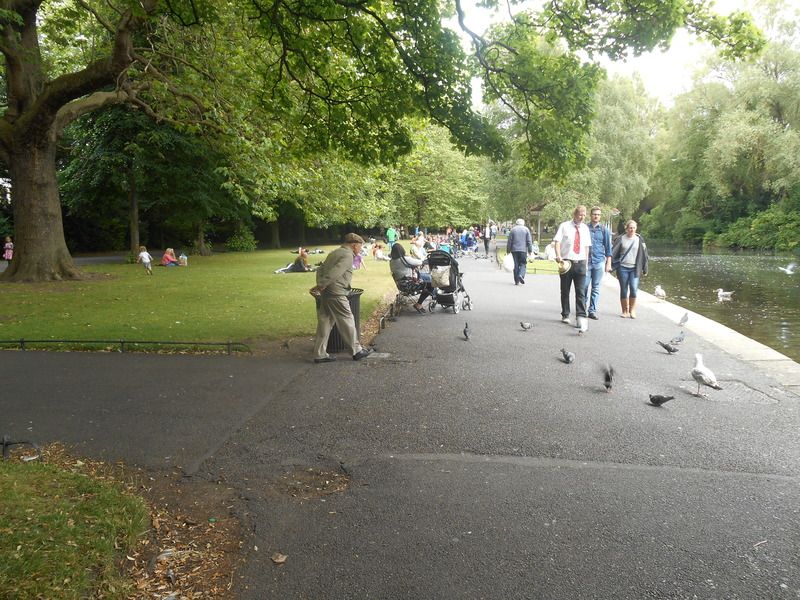
It’s an absolutely beautiful park. Once you’re inside, you really don’t get a sense that you’re in the middle of Dublin. Because the weather was so nice, the park was quite busy, but it never felt crowded. I spend some time wandering around, enjoying the sights, and I had a small picnic near a pond with ducks.
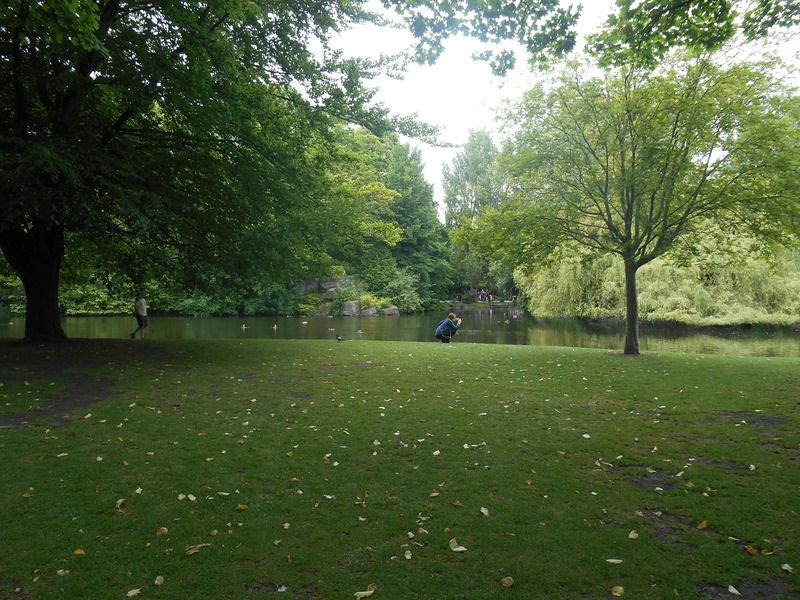
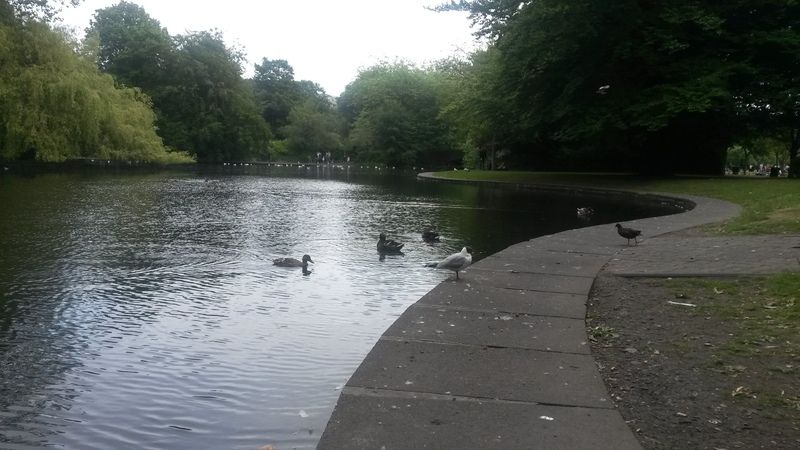
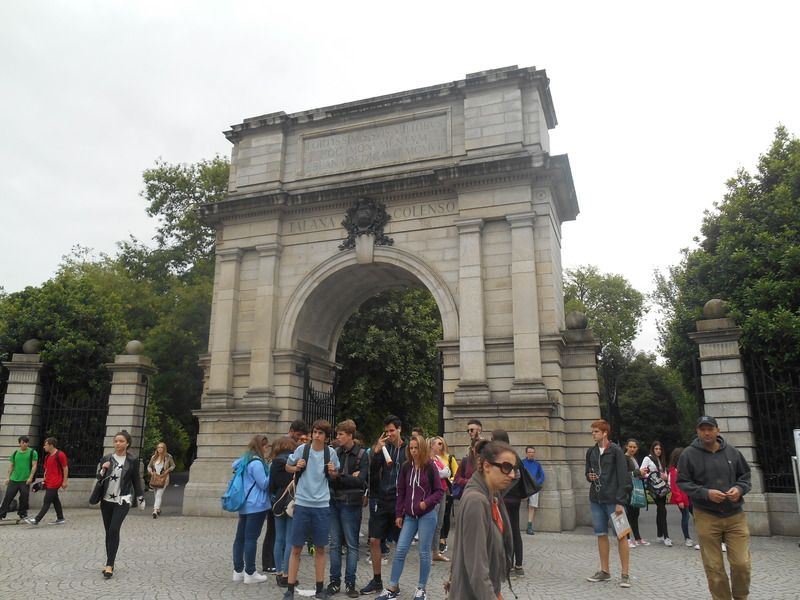
The entrance to St Stephen's Green; the arch is modeled after the Arc de Triomphe in Paris. Also pictured: a few of the many Italian/Spanish students.
At about 4 I decided to head back to the hostel. I walked through Grafton Street, which was super busy with shoppers, buskers and living statues, and past College Green, which was super busy with traffic! I headed towards O’Connell Street, then took a left turn through Fleet Street (didn’t spot any Demon Barbers) into Temple Bar. It’s got quite a nice atmosphere at the end of the afternoon, very leisurely. The streets are narrow and with cobbled stones and there are loads of colourful pubs.
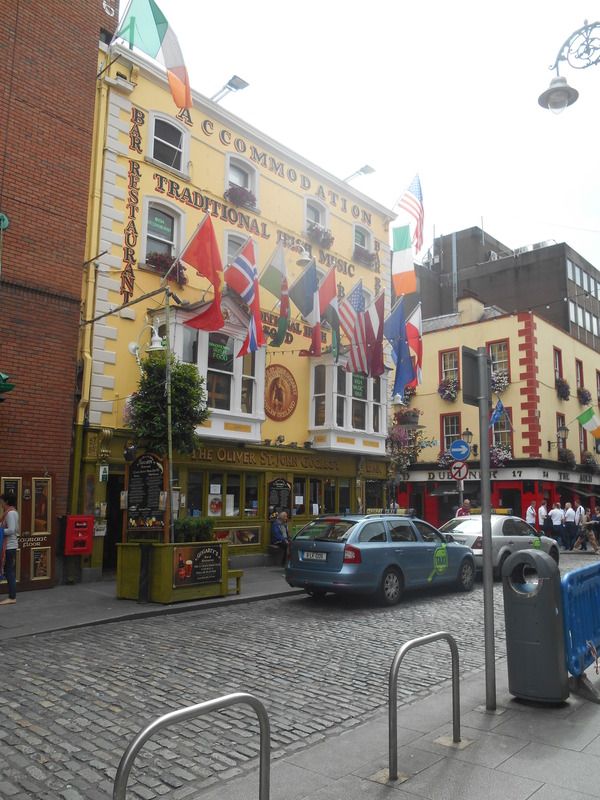
I also managed to finally find the Irish Film Institute! Took me only three times. Turned out you had to go through a narrow passageway and there was only a little sign pointing the way. Sadly, they didn’t have The Art of the Secret of Kells either.
I crossed the Liffey using the Millennium Bridge (will I ever use the Ha’penny Bridge? :p). There was a violinist on the other side, playing Irish tunes, giving that “yes, I really am in Ireland” feeling. Back in the hostel, I rested my feet for a while (my knee had behaved perfectly all day - the problem was probably that I hadn’t been able to walk at my own pace during the guided tour). My American roommates were really gone, but they had been immediately replaced by new roommates.
Dinner was a salad at the salad bad next door, then I spend the rest of the evening writing my travel journal in the dining room in the hostel basement. After that, a shower and an early night, since tomorrow I’d go to Newgrange and the Hill of Tara!
Friday July 10
I woke up much too early with a sore throat. Bleh. I got up at around 7, had breakfast, packed my backpack, then headed out for O’Connell Street at 8:35. The bus would leave at 9, so I should have had plenty of time, were it not that I missed the bus stop and walked way too far! I realised my mistake, quickly walked back and did manage to catch the bus, but only in the nick of time. Whew.
The bus driver slash tour guide was called Harry. He was a typical Irishman, talked a mile a minute about history and anything interesting we passed along the way, and he even sang! He’d basically explain something, then go “and that reminds me of a song...” and start singing. Also, he wore tweed. :p
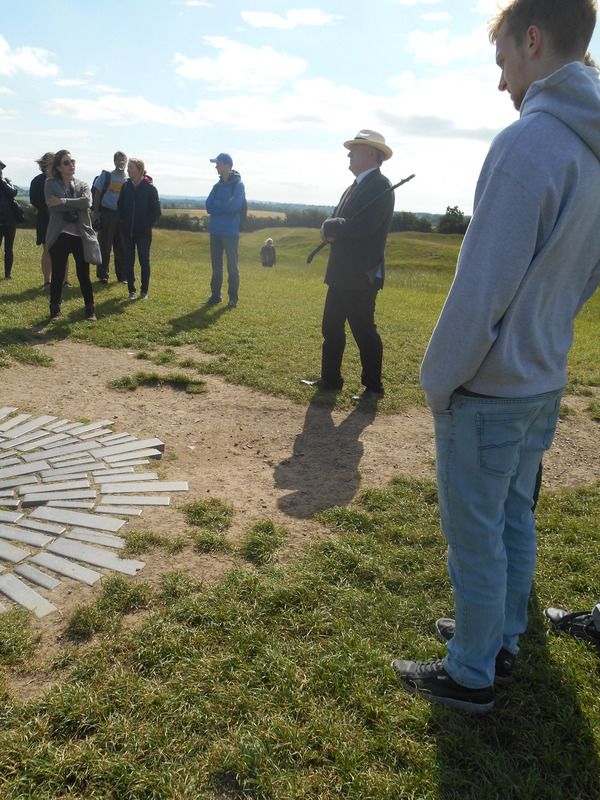
Harry, explaining something and not singing - for the moment.
Our first stop was the Hill of Tara, the seat of the High King of Ireland. Harry of course told us loads about it as we drove to it. It’s situated among lovely green fields - lots of green of course. There was a little sun, and we were the only group of people visiting, so it was quite peaceful.
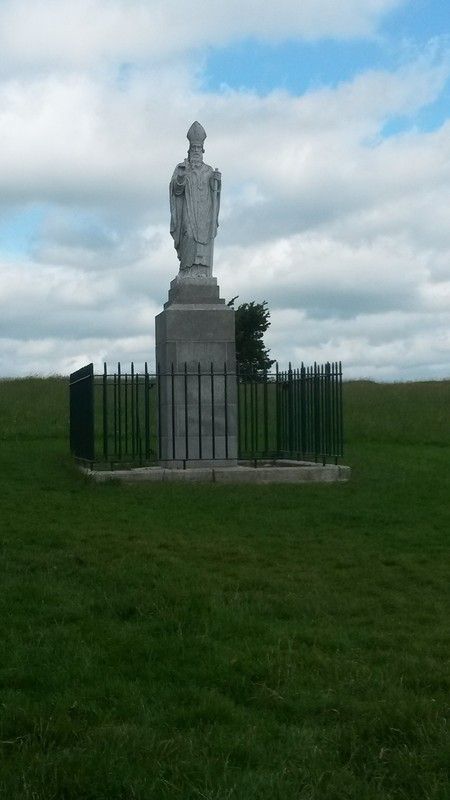
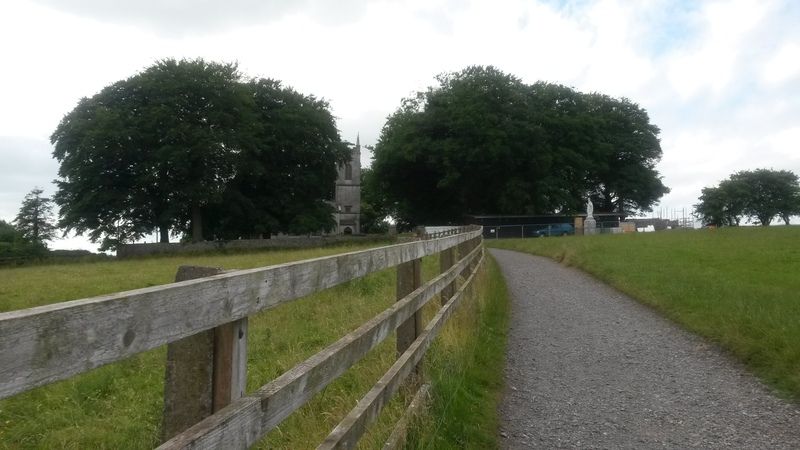
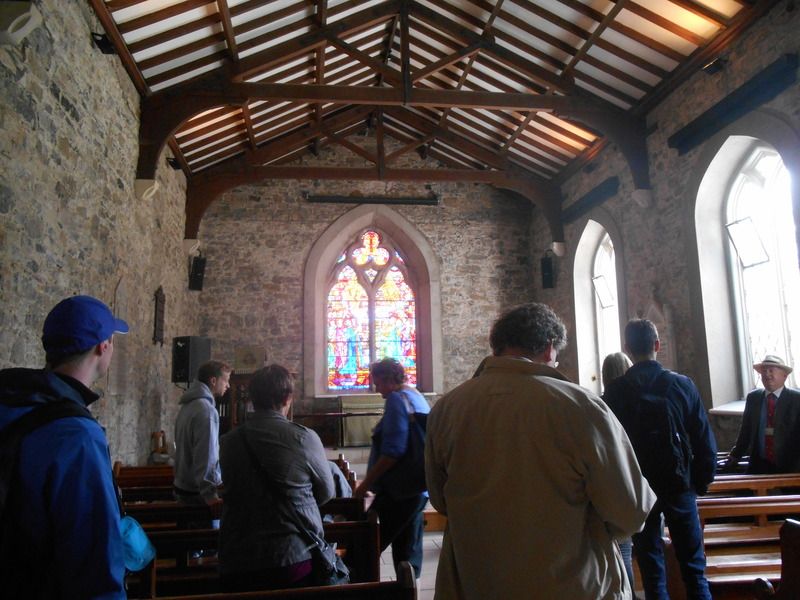
There is a statue of St Patrick and a small church right on the edge of the Hill, because this is Ireland and of course there is.
The main attraction at the Hill of Tara is the Lia Fáil, or Stone of Destiny. It’s a stone pillar (Harry: “it does look a bit suggestive, doesn’t it?”).
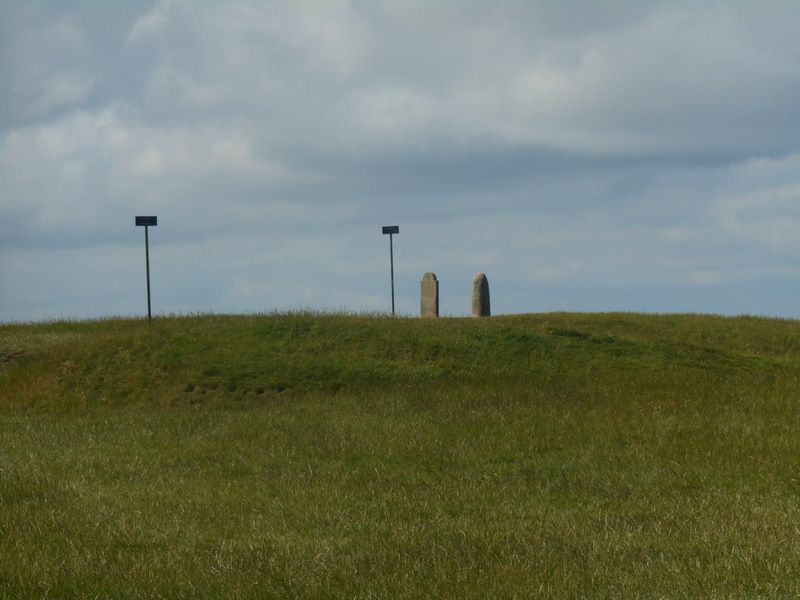

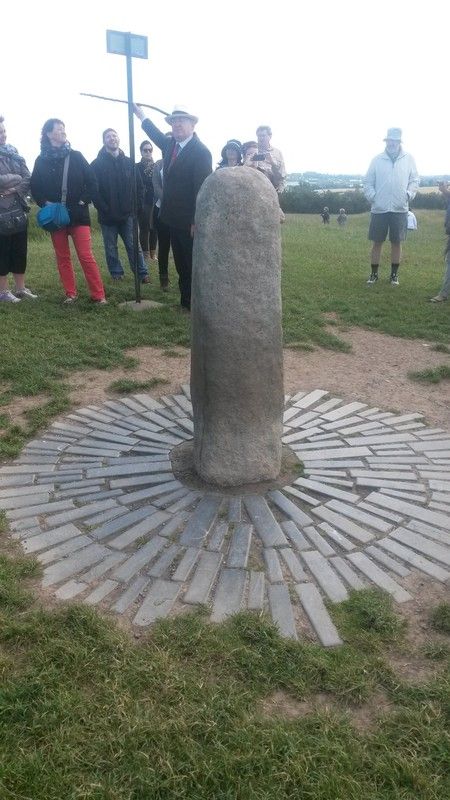
According to Harry, the high kings were supposed to put their hands on the stone during their coronation. The stone would cry out if anyone who wasn’t worthy of being the king did so - it would stay silent otherwise. Of course, everyone then wanted to take a picture of them putting their hands on the stone! It stayed silent, but as Harry said, “don’t quit your day job.”
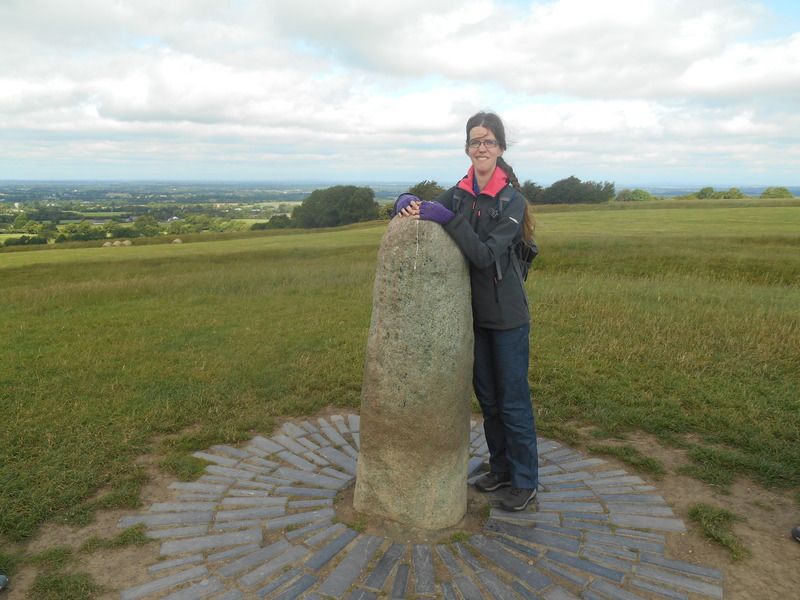
(I later got a book of legends about the Hill of Tara, which said that it was exactly the other way around, the stone would shout when the rightful king touched it, but eh. It was a nice story anyway. :p)
We also looked at the Mount of Hostages, a small Neolithic passage tomb similar to Newgrange but on a much smaller scale. The entrance was blocked by iron bars, but you could peer inside and still see some prehistoric decorations (and some modern trash, sigh).
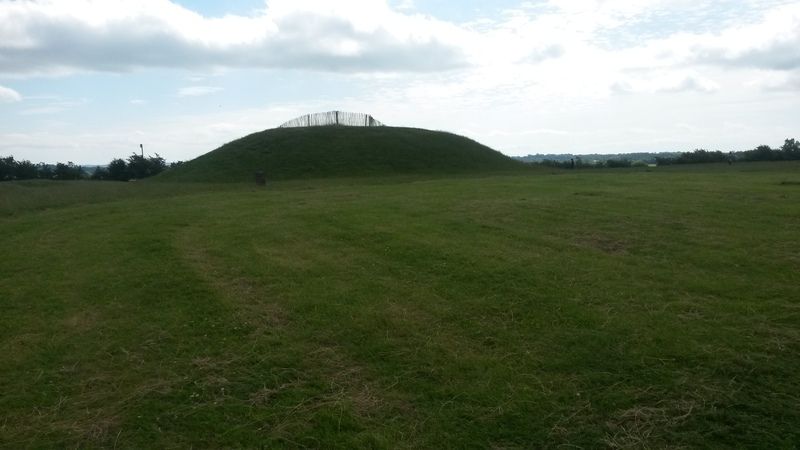
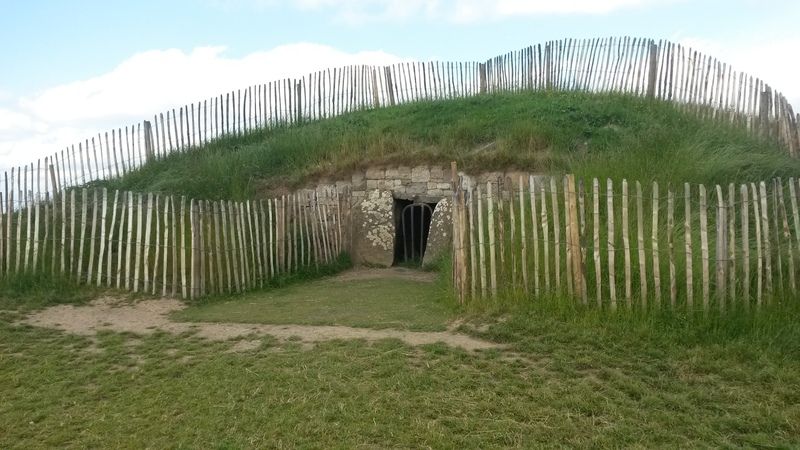
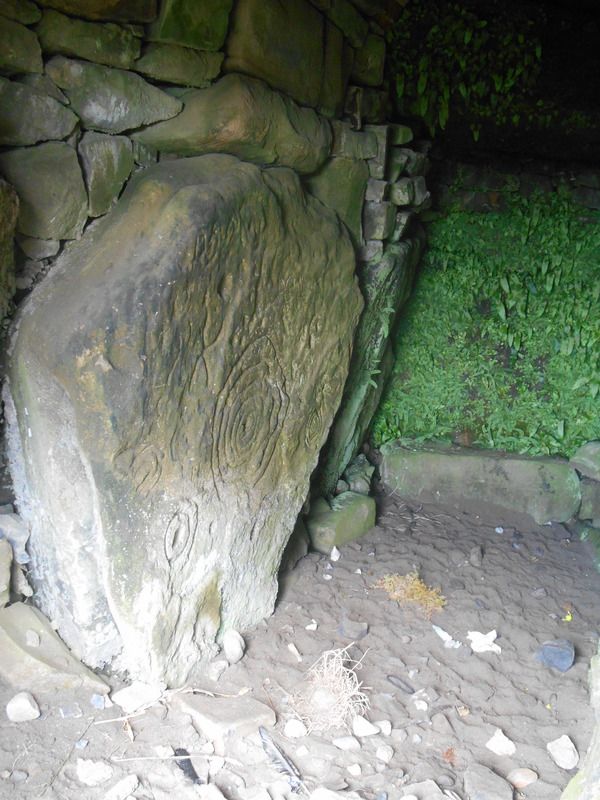
After shooting some pictures, the rest of the group headed back to the café/gift shop, but I stayed behind a bit, to take photos and make some sketches of the Hill, the countryside and of the faerie tree, which had ribbons, bits of paper and other stuff tied to it, to appease the faeries and ask their help.
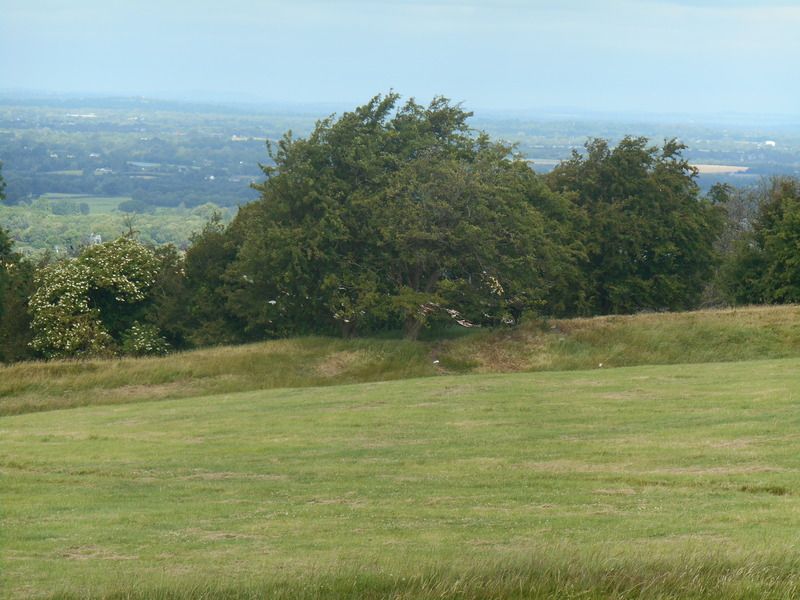
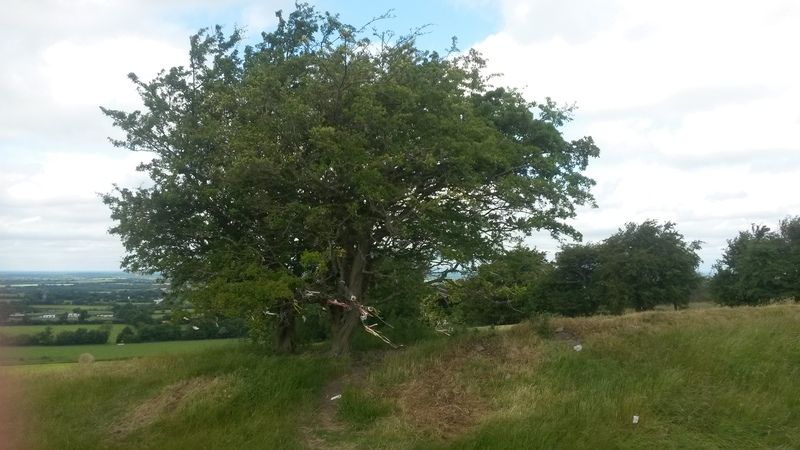
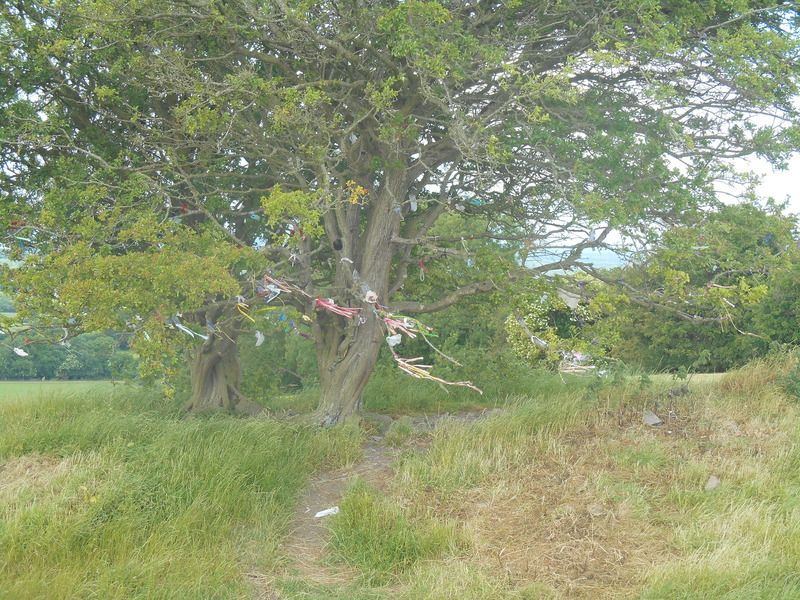
It was really quite magical to see it at that spot, a sign of the Irish belief in the supernatural, and it really added to the very peaceful atmosphere. It was just me, the sun on my face and the sound of the wind rushing through the grass and the trees, here at the seat of the High Kings.
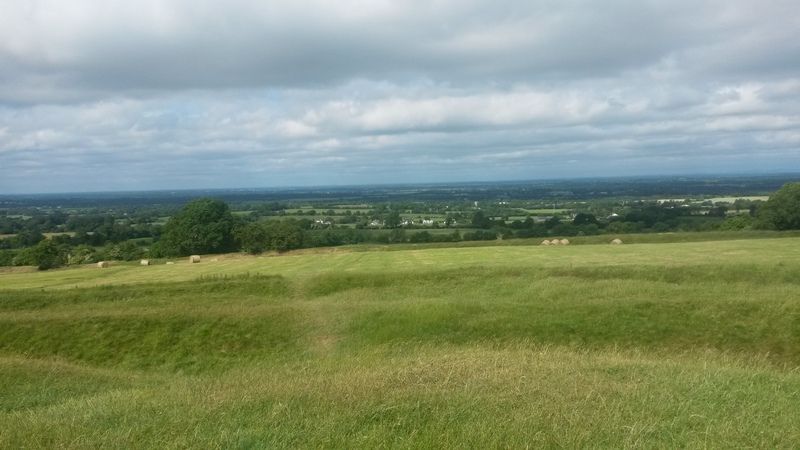
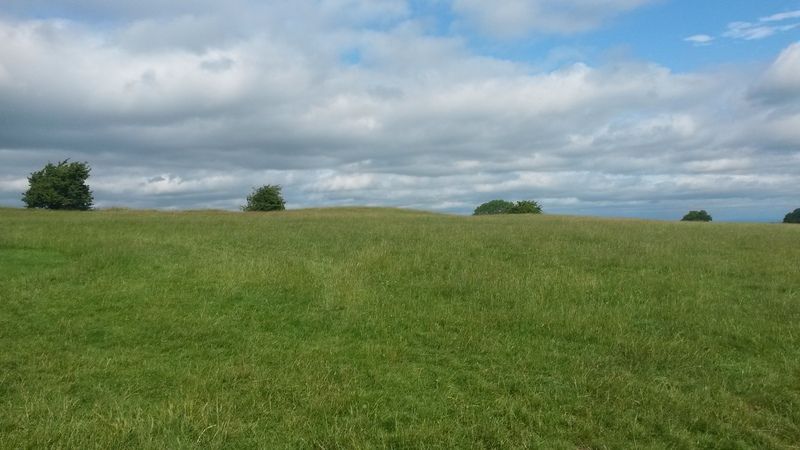
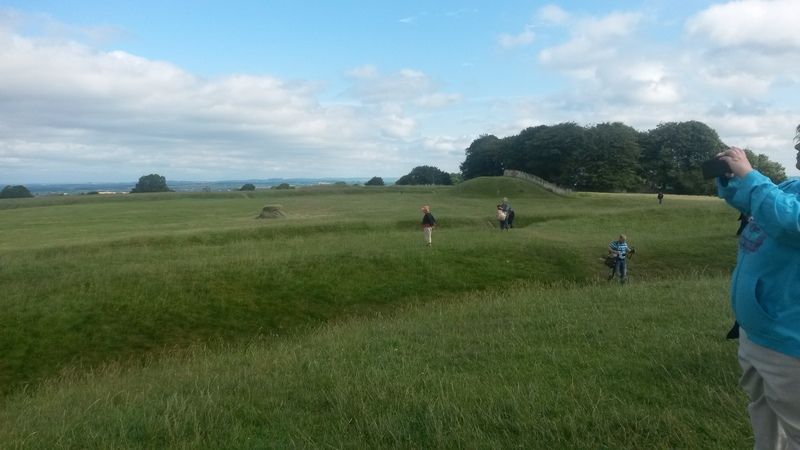
(The little church is behind the trees on the right.)
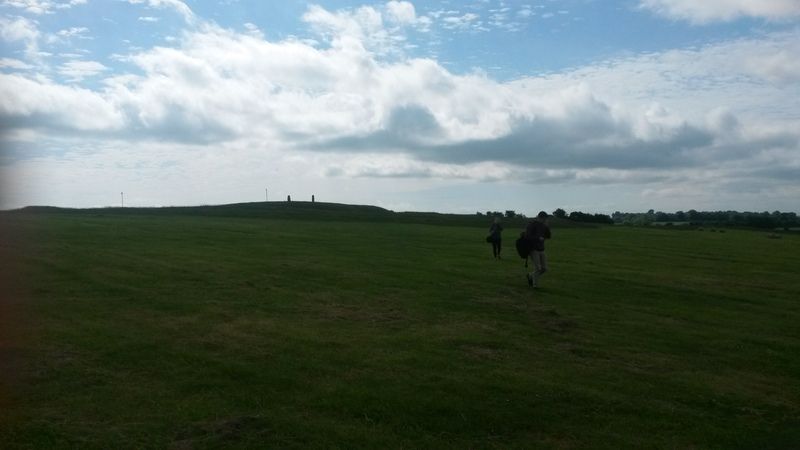

Sadly the bus had a strict departure time, so I had to head back. I stopped briefly at the gift shop and got a book on legends about the Hill of Tara, then got back on the bus. We headed on towards our next stop and the main stop for the day, Newgrange. On the way there, Harry told us about the Battle of the Boyne, Slane castle (which we passed, nice medieval castle), the legend of the Salmon of Knowledge, how Irish number plates on cars work, and he made Gone with the Wind jokes (“Scarlet O’Hara’s plantation was named Tara, for the Hill of Tara. Now, you might be glad to know that, or you might think ‘frankly, I don’t give a damn’”).
The weather had turned absolutely perfect when we arrived at Newgrange, slightly after midday. We were first herded through the visitor centre, including a video presentation and an exhibition about prehistoric life at the time when Newgrange was build.
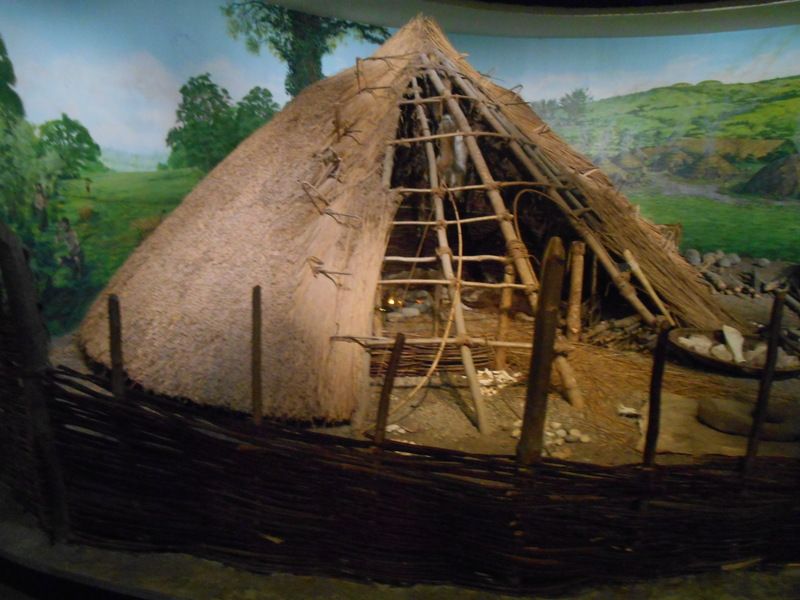
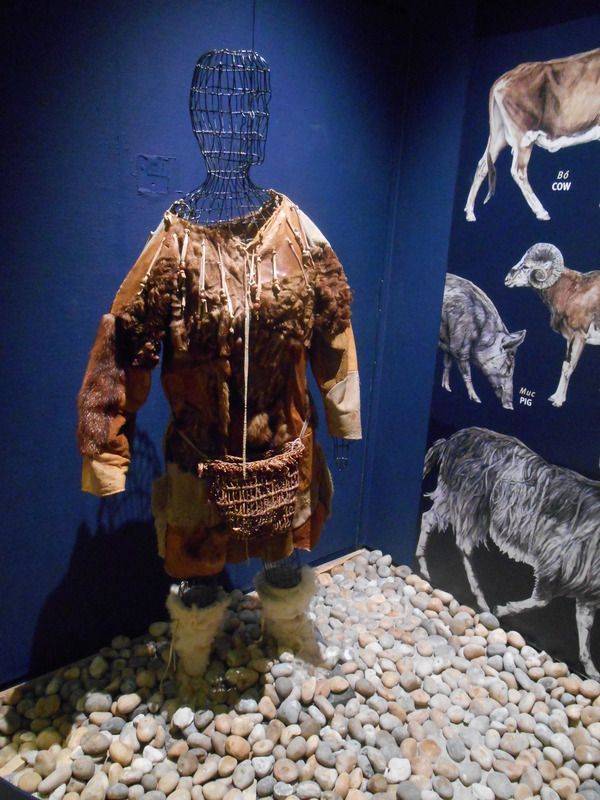
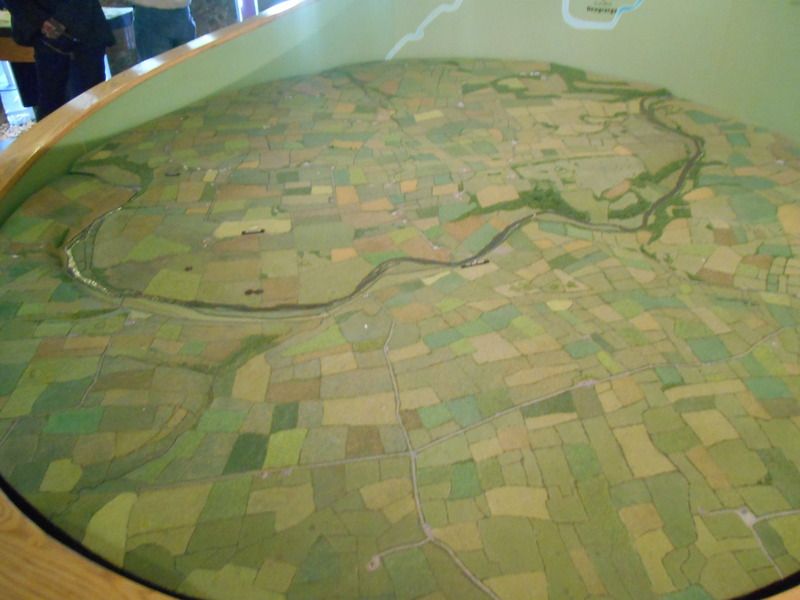
Scale model of the valley Newgrange is in.
After that, we each received a sticker signifying which group we belonged to (Newgrange is only accessible through the visitor centre and each group has an allotted time so the monument isn’t overrun by random people) and were led to the bus to the monument.
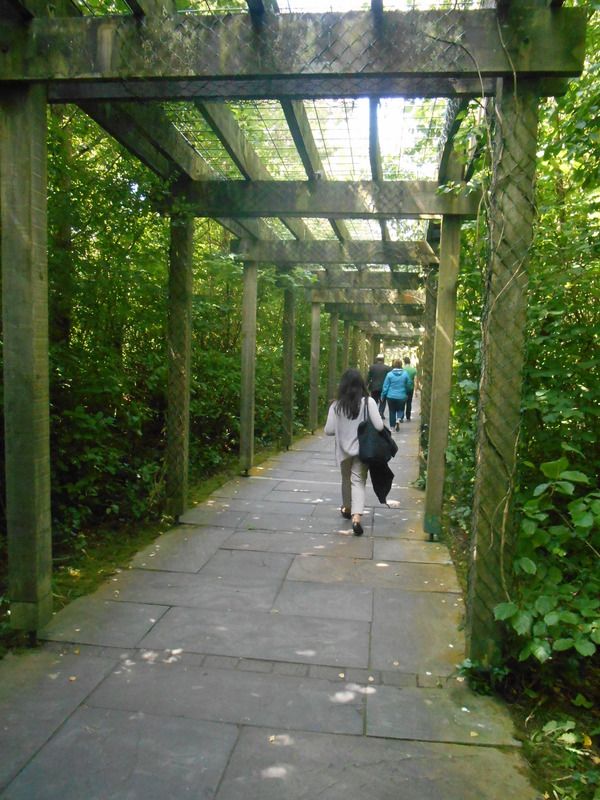
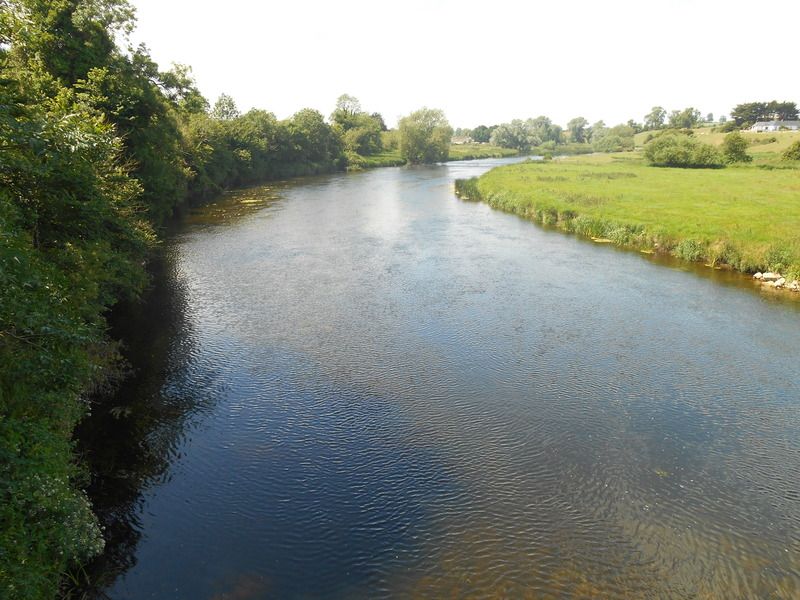
The view during the walk to the bus wasn't so bad!
A short ten minute drive later, we were there.
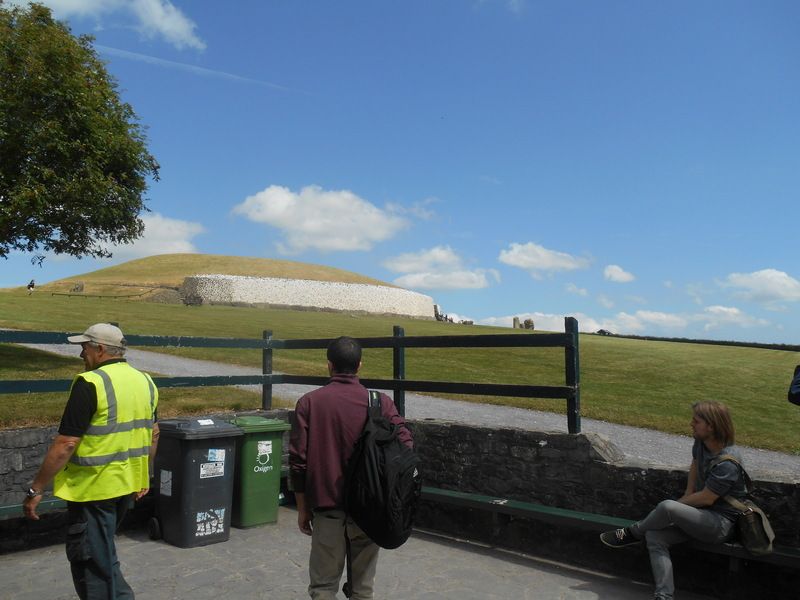
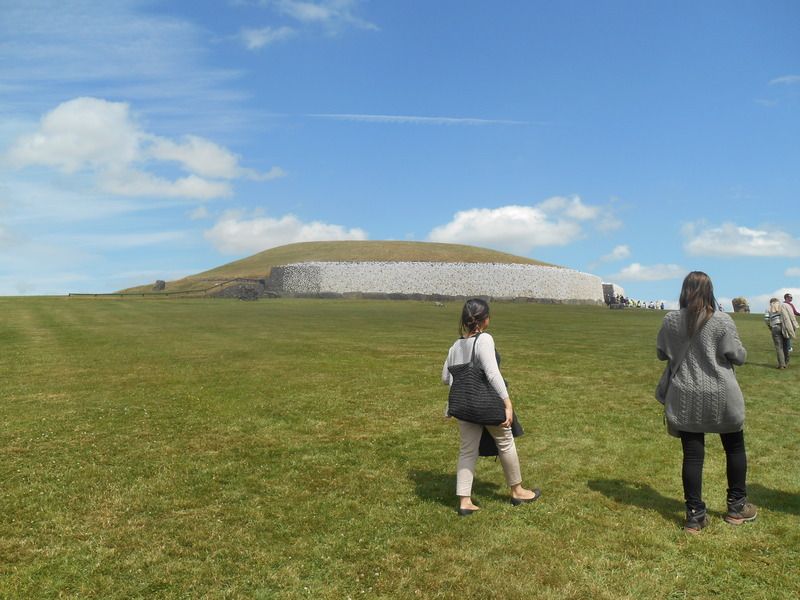
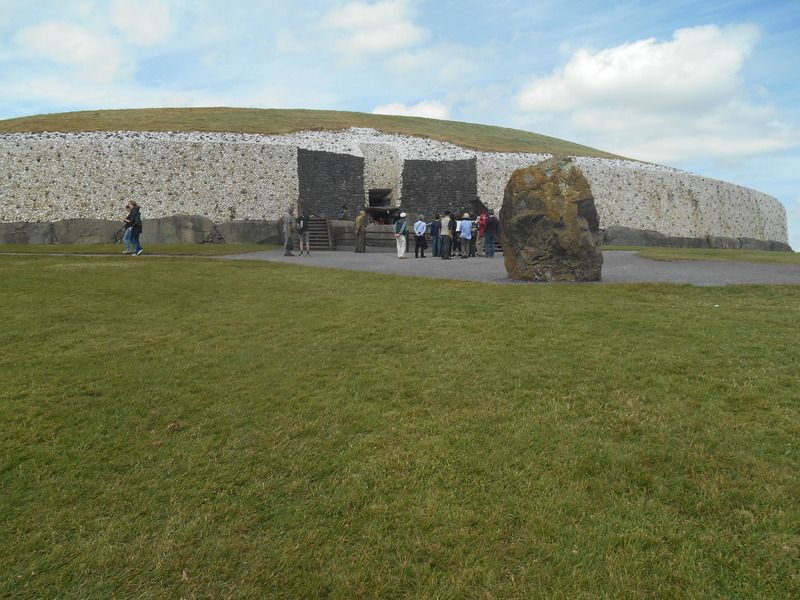
It was... amazing. Especially considering the history: build at around 3200 BC, so over five thousand years ago, before Stonehenge or the Egyptian pyramids, then sealed, covered by vegetation, forgotten and literally passed into myth (it was believed to be the home of the most powerful of the Tuatha De Dannan) until it was rediscovered in the 17th century and only truly excavated in the 1970s. Newgrange is a passage tomb, although archaeologist aren’t entirely sure what it was used for exactly - human ashes have been found in the central chamber, so it might have been used as a burial/cremation site, but it’s not sure whether that was its main purpose. It probably did have religious significance, judging by the decorations, the famous triple spirals, and its most distinctive feature: the roofbox over the entrance.

Entrance with the roofbox (opening) above the entrance. Note the stairs to get over the huge kerbstones.
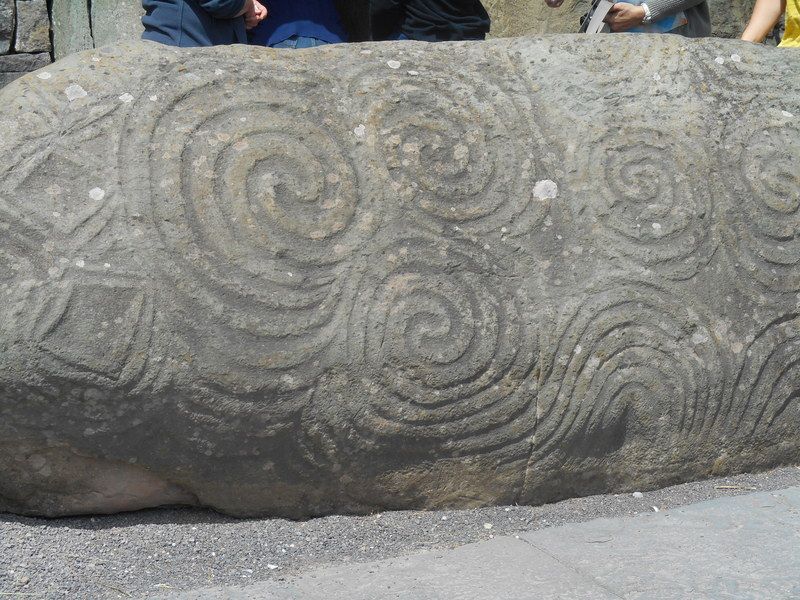
Triple spirals on the kerbstone.
Every year at the midwinter solstice (December 21), the light of the rising sun falls through this opening, straight through the 19 meter corridor all the way to the back of the central chamber, on a carved triple spiral. (Although these days the light doesn’t reach the chamber until about four minutes after sunrise, because the earth has tilted a bit in the past five thousand years.) This feature wasn’t rediscovered until 1963, when an archaeologist discovered that there used to be an opening above the entrance and he wondered what it could have been used for. These days, if you want to be inside the chamber to witness it, you have to enter a lottery and hope you’re one of the lucky ones out of a few thousand people. (And according to the tour guide, it’s a double lottery - you might win entrance to the chamber, but considering the Irish weather it’s not certain whether you’ll actually see the sunrise!)
I had booked a tour with guaranteed entrance, so we were greeted by a tour guide (Harry had stayed behind) who would take us inside. She told us to take our backpacks off and carry them below our knees, as the passageway was quite narrow. She also recommended to watch our heads as we were a bit taller than most prehistoric people. :p
The passageway wasquite narrow, not very good for my claustrophobia! Some of the bits were uncomfortable, especially the places where you had to walk almost bend over, shuffling with a backpack held below your knees. The passageway also tilted up slightly, not enough to really notice it but enough to make it somewhat difficult to walk. But the inner chamber was worth it. It was about five meters in diameter (they only allow about ten people at the time for that reason), with three smaller chambers off to the sides. The tomb is completely handmade but entirely out of stone so it gives the impression of a cave. Even though the top of the monument was only a few meters above my head, it still gave the impressive of being deep below the earth. Although caves are not my favourite places to be (see claustrophobia), the inside of Newgrange was really serene and in a way quite welcoming.
The tour guide pointed out some interesting features, for example the graffiti on the stones, both prehistoric and... from 1891! (Somehow had carved his name on the walls.) She also explained that the roof was build with overlapping stones, like an igloo, and then covered with grass and moss. It was so well build that it’s still completely waterproof after five millennia. Then came the show-stopping bit. She told us to stand to the side and clear the way so everybody could get a good view of the passageway. Then she turned off all the lights until it was pitch black. We waited a few seconds... and then a narrow beam of light fell across the floor, widening as it grew stronger and reached until the back of the cave. When the floor was entirely illuminated, the guide switched on the main lights again. It had been completely silent all through this as everybody was so impressed with the downright magical sight - and that was only a simulation! The tour guide told us she had been in Newgrange during the solstice once, witnessing the real deal. Her face lit up as she told us this; it really must be amazing.
I didn’t really want to leave the inner chamber, but sadly I had to as the next group was waiting to come in. Even so, I was the last to leave. :p Once back outside (wow, so much sunlight), I sauntered around the monument, taking pictures and making some sketches. By this time it had got positively warm, although there was a strong wind so I still needed my coat.
Newgrange from the back:
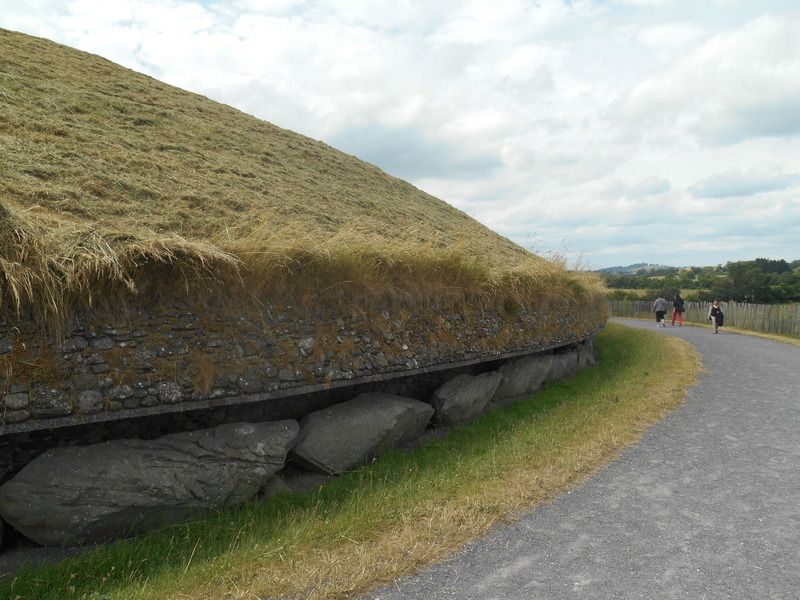
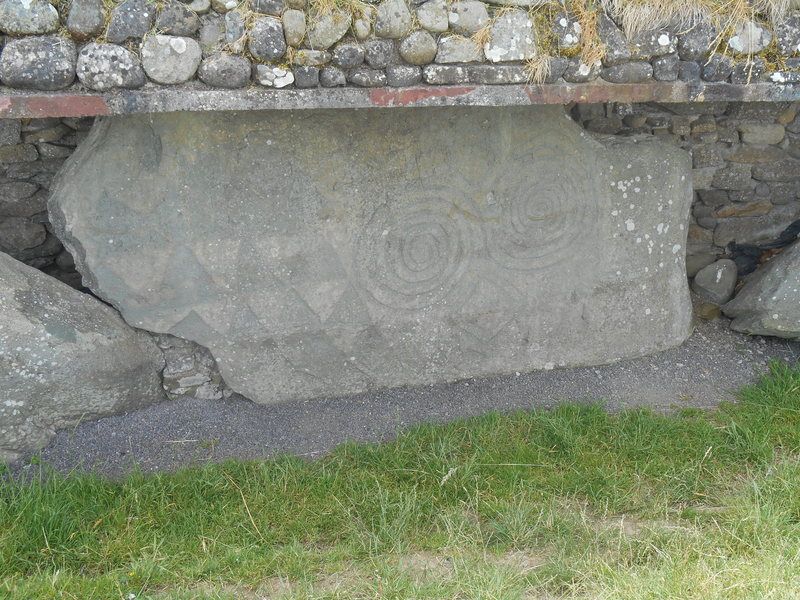
More prehistoric decoration.
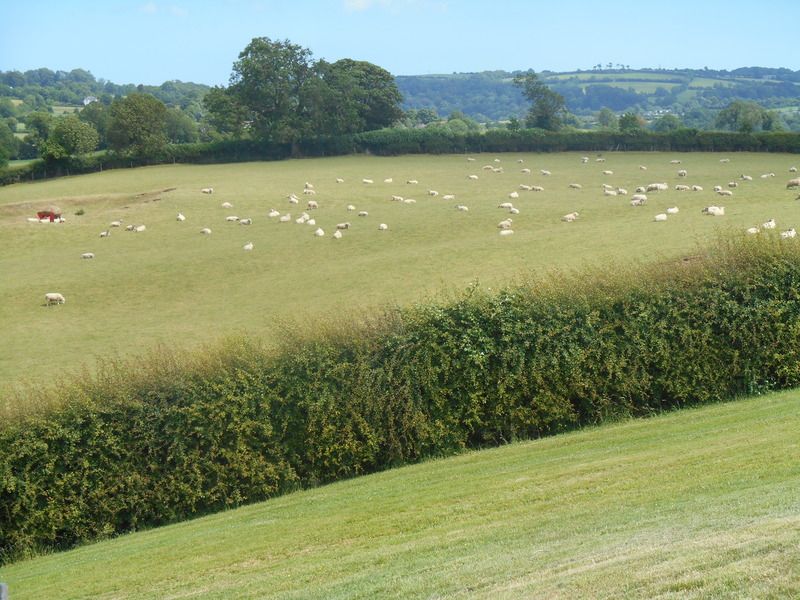
Sheep, because Ireland!
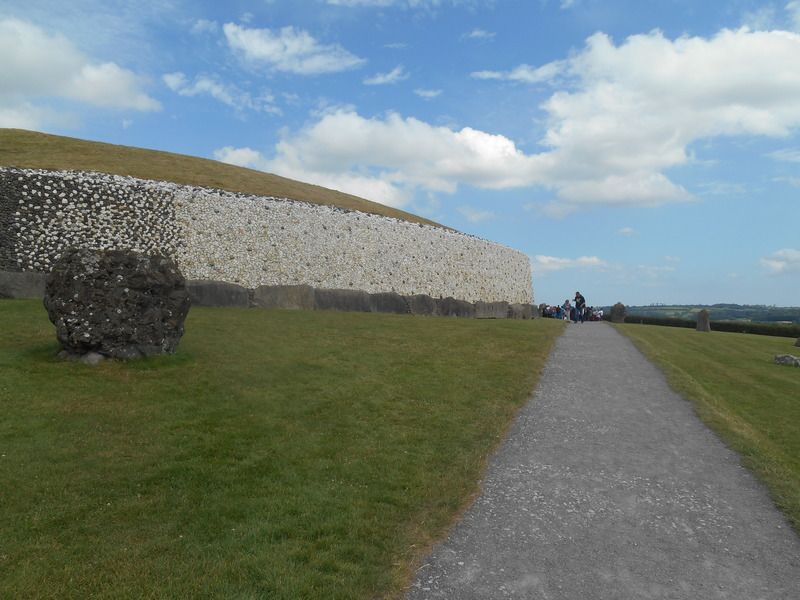
Newgrange from the side. The grass/moss on the top is only a few inches thick, at most, the rest is stone.
Once back in the visitor centre I bought some souvenirs - a book about Newgrange and a pair of triple spiral earrings. The rest of the group had headed to the café for lunch, but it was much too crowded there for my taste. Instead, I already headed back to where our bus was, taking my time enjoying the view. I had packed a lunch so I ate while enjoying the sun. Harry was doing the same, so we had an amiable chat about Ireland and being a tour guide. It turned out that he was actually a pensioner who had worked in sales! That explains the easy chatter. :p
Once everybody was back we continued our trip to Howth, a fishing village close to Dublin. Harry had apparently grown a little tired of talking (hard as it was to imagine) so we had lovely Irish tunes on the radio. Unfortunately traffic wasn’t cooperating so we had to take the scenic route rather than the fast route - but nobody really minded. Sadly, by now the weather had also turned and it had begun to rain. That plus a long tiring day didn’t really make me like Howth. It was okay, but there isn’t much interesting about a harbour in the rain with a row of fish restaurants on one side.
We drove back to Dublin along the coastline, stopping along the way for a few photo ops and with Harry back to his information dispensing mode, about Bram Stoker (a native Dubliner) among other things.
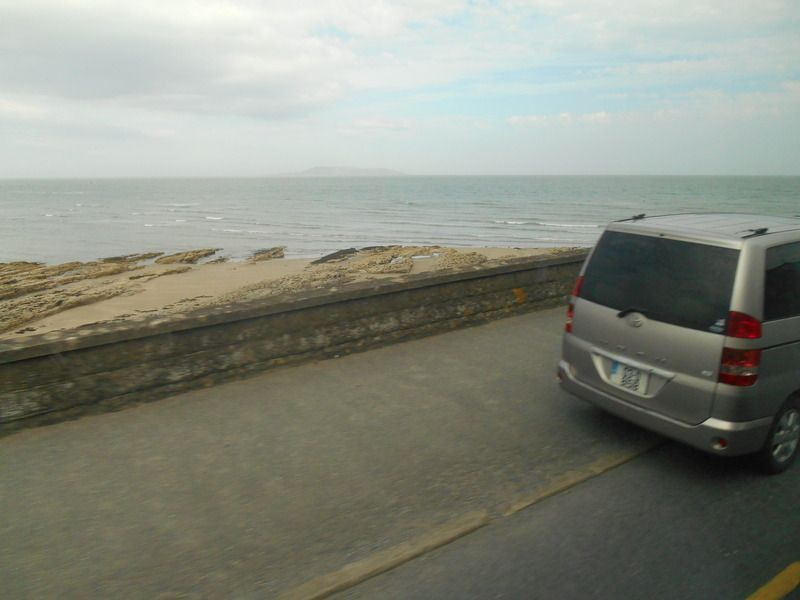
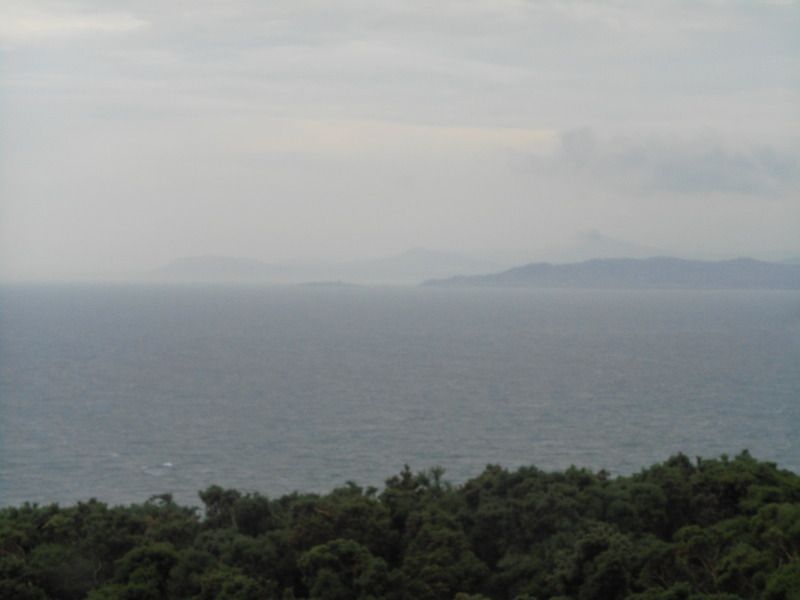
Dublin Bay in lousy weather.
We were back in O’Connell Street at 17:30. I was too tired to get complicated with dinner, so I stopped at McDonalds on the way to the hostel and smuggled the bag with a hamburger and fries to my room. Irish McDonalds tastes as well as Dutch McDonalds does, but it was warm, greasy and salty and that was all I wanted.
I had two new American roommates, much nicer than the previous ones had been. I chatted with them for a bit (turned out they studied in Ireland), then had an early night.
Thursday July 9
I took it easy this morning because of my knee. My roommates were up early, packing their things and apparently heading out. I wouldn’t miss them; the New York girls were particularly unsocial (living up to the stereotype I guess?). I had a leisurely breakfast, then headed out at 9:45, to the bus service office thing on O’Connell Street. Along the way, I passed the Post Office, where the Easter Rising had taken place. A lovely building, still in use. They also had a stamp museum but I decided to skip that. :p
The bus service was a little further down the street. It turns out they have a chip card system similar to the Oyster card in London, except it’s called a Leap card here. It’s green and has a frog for a logo, surprisingly. ;) It’s valid for 5 years, so if I manage to get back to Dublin in the next five years I should remember to bring it with me! I put ten euros on it, then headed to the bus stop to take the bus to Merrion Square.

The monument for Daniel O'Connell on top of O'Connell Street, near the bus stop.
I didn’t have long to wait. I got on the bus, passed my card over the scanner and sat down. An old lady sat down next to me. As I observed the other passengers, I noticed that nobody was passing their card past the scanner as they got off... so I asked the lady if I needed to check out with my new Leap card?
Turned out she travelled for free since she was a senior, so she had no idea, but we did have a fun conversations about where I was from (she complimented me on my English), where I was going, what my plans were, what a shame it is the Irish speak only one and a half languages (English and a little Irish), etc. Halfway through our conversation we were joined by a Dutch lady at the other side of the aisle, who explained the Leap card system to me. Turns out that you don’t check out - in fact, you don’t even really check in. You tell the bus driver where you want to go, and he passes the card past a scanner so the right amount of money is written off. If you use the scanner yourself, you write off too much for most destinations in Dublin. Is it just me or is that a really complicated system?? Oh well.
I kept chatting with the old lady until I reached my destination (turned out she had been to America and Australia as well, and was really pleased to hear I would be going to Galway and Inishmore as that was the ‘real’ Ireland) and got off, wishing the old lady a nice day. It turned out the bus stop was right in front of Oscar Wilde’s childhood home!


Right opposite that, in Merrion Square Park, was the famous statue, the Fag on the Craig (thanks, Dubliners). I had lunch there, in the morning sun with a view of Oscar. They had pillars with some of his quotes next to the statue so I spend a few amusing minutes reading them all.

Is it me or is he kind of leering at everyone?

[insert witty bon-mot here]
Lovely park though.

Albeit with some disturbing statues:



Michael Collins, looking more like Louis van Gaal than Liam Neeson.

Merrion Square is surrounded by row houses, which all look very similar. Of course, the people living here didn't want their house to look exactly the same as their neighbours', so every house had a different front door! This picture looks photoshopped but it really wasn't. :p
After my lunch, I walked through the park (nice and quiet, very peaceful) to Number 29, a museum about Regency-era Dublin. I couldn’t find it at first, but it turned out I was looking with my nose as there was a huge sign outside. Oops. Entrance was through the servants’ entrance, downstairs.

"Hmm I wonder where the museum is?"

It was a really fun museum. The house used to be owned by a Mrs Beatty and her 7 children, in the early 1800s. It has been restored to what it had been like back then, from the kitchen and scullery to the nursery up top. Really interesting, especially if you are interested in Jane Austen! Especially amusing to see how the kitchen downstairs was very sober and utilitarian, then the first floor with the salon was very beautiful and ornate, the bedroom above that slightly less so, and the nursery up top very bare with second-hand furniture. No visitors ever got there so why would they need to decorate that? Even the carpet on the staircase got shabbier as you went upstairs. :p I especially liked the nursery, to see how education was handled at that time.
Sadly, I wasn’t allowed to take pictures. I did spend some time talking to one of the guides there, about the Anglo-Irish, where Mrs Beatty would have send her children to school (boarding school naturally), and the role of Catholic people in Irish society at that time. She also mentioned that my English was so good. Yes, I know. :p
I headed out again, to go to the National Museum of Archaeology. According to my map, it should have been relatively easy to find. Of course, in real life, that doesn’t always follow! As I was studying my map, trying to figure out which of the many narrow streets was the easiest way to get there, I was approached by an older gentleman: did I need any help?
Me: “I’m looking for the National Museum.” *shows map*
Him: “ohh I have no idea how to get there... But where are you from?”
Me: “the Netherlands.”
Him: “your English is very good!”
I knoooooow, hahaha. Cue a long conversation (well, mostly a monologue from his side) about what a shame it is that so few Irish people really speak Irish fluently, he barely knew any either, it was all because of ‘the Brits’, did I know what he meant by that, such a shame, oh where was I going, oh the museum, no he didn’t know how to get there, but he’d heard it was really interesting, was I staying in Ireland long, where was I going after this, did I know any Irish, oh “cáed mile fáilte”, very good, very good. Etcetera, etcetera. :p
After about fifteen minutes or so, when he still hadn’t been able to tell me how to get to the museum but I did get a quick lesson on the history of the oppression of the Irish language, we said goodbye. I’d asked him what “hello” was in Irish, he didn’t know, but he did know “goodbye”, which was “slán leat!” So we said goodbye in Irish. :-)
I followed the route he thought was probably the most likely to lead to the museum, and wandered around some more. It had turned quite warm by then, which makes being lost quite annoying.

That's one way to make your house easy to recognise.

Eventually, after some wandering, I found St Stephen’s Green (it’s not really hard to miss, really), Dublin’s central city park, which is close to the museum. After a little more searching (they might make the signposts a little easier to find...), I even found the entrance! Yay. :p

Like all large museums in Ireland, the museum was free! I did head for the café first thing because I was parched after walking in the sun for so long, and my Wilde lunch had been a while ago. While in the café I also discovered that my coat fit in my backpack, which is very convenient, haha.
Astonishingly enough, this museum was all about... archaeology! Ireland has of course a very rich history, so they had large exhibits about all kinds of stuff they had dug up from the peat bogs. Even one entirely about gold, which was apparently plentiful in Ireland.

The central hall with the Irish gold exhibition.

It was really interesting and neat to see in real life. Especially the ‘real Irish’ things were beautiful, and it was amazing to think that some of these things were a few thousand years old. Some person had spend ages crafting the most delicate thing, and here I was centuries, even millennia later, looking at it.




This looked almost Gallifreyan...
They also had an exhibit about bog bodies. Ireland has large peat bogs. The bogs have highly acidic water, low temperature and no oxygen, so the bodies put in the bogs are naturally mummified. Because of the nature of their mummification, the skin doesn’t get dissolved but gets tanned like leather, leaving the bodies well preserved. Most people found in the bogs were probably human sacrifices, judging by the nature of their wounds.

They got really creative with them, too.
Honestly, this exhibit was mostly just sad. With mummies, you know it’s a dead person in there, but it doesn’t really look like a recognisable person because of all the wrappings. A bog body, on the other hand, really does look like a person, albeit sometimes a deflated one. :p But you can still make out the hair, the fingernails, stuff like that. You really get a sense of “this was once a person just like me, and now they’re dead and I’m looking at the corpse in a museum.”

It also didn’t help that there were groups of teens running amok in the museum, who thought the bog bodies hilarious... The museum was overall overrun by barbarians, including a woman who actually touched an Egyptian statue. Was she raised by wolves??
There was also a bit about excavations at the Hill of Tara, which was especially interesting since I would be visiting it the next day! They had a scale model and everything. The two circles (labeled 1, 3 and 5) are most important parts, the Mount of the Hostages and the Stone of Destiny.


And this really amused me since the Lebor Gabála Érenn also appears in a D&D game my friends and I are playing!
I spend about an hour in the museum - it’s not that big, and most of the medieval and Egyptian stuff was pretty similar to things I’d seen in the British Museum, the Louvre and Leiden (yep, I’m museum blasé). So I headed out again. Since it was a beautiful day, I walked over to St Stephen’s Green. It’s a large park, right in the centre of Dublin. Grafton Street actually ends right at the entrance to St Stephen’s Green!

It’s an absolutely beautiful park. Once you’re inside, you really don’t get a sense that you’re in the middle of Dublin. Because the weather was so nice, the park was quite busy, but it never felt crowded. I spend some time wandering around, enjoying the sights, and I had a small picnic near a pond with ducks.



The entrance to St Stephen's Green; the arch is modeled after the Arc de Triomphe in Paris. Also pictured: a few of the many Italian/Spanish students.
At about 4 I decided to head back to the hostel. I walked through Grafton Street, which was super busy with shoppers, buskers and living statues, and past College Green, which was super busy with traffic! I headed towards O’Connell Street, then took a left turn through Fleet Street (didn’t spot any Demon Barbers) into Temple Bar. It’s got quite a nice atmosphere at the end of the afternoon, very leisurely. The streets are narrow and with cobbled stones and there are loads of colourful pubs.

I also managed to finally find the Irish Film Institute! Took me only three times. Turned out you had to go through a narrow passageway and there was only a little sign pointing the way. Sadly, they didn’t have The Art of the Secret of Kells either.
I crossed the Liffey using the Millennium Bridge (will I ever use the Ha’penny Bridge? :p). There was a violinist on the other side, playing Irish tunes, giving that “yes, I really am in Ireland” feeling. Back in the hostel, I rested my feet for a while (my knee had behaved perfectly all day - the problem was probably that I hadn’t been able to walk at my own pace during the guided tour). My American roommates were really gone, but they had been immediately replaced by new roommates.
Dinner was a salad at the salad bad next door, then I spend the rest of the evening writing my travel journal in the dining room in the hostel basement. After that, a shower and an early night, since tomorrow I’d go to Newgrange and the Hill of Tara!
Friday July 10
I woke up much too early with a sore throat. Bleh. I got up at around 7, had breakfast, packed my backpack, then headed out for O’Connell Street at 8:35. The bus would leave at 9, so I should have had plenty of time, were it not that I missed the bus stop and walked way too far! I realised my mistake, quickly walked back and did manage to catch the bus, but only in the nick of time. Whew.
The bus driver slash tour guide was called Harry. He was a typical Irishman, talked a mile a minute about history and anything interesting we passed along the way, and he even sang! He’d basically explain something, then go “and that reminds me of a song...” and start singing. Also, he wore tweed. :p

Harry, explaining something and not singing - for the moment.
Our first stop was the Hill of Tara, the seat of the High King of Ireland. Harry of course told us loads about it as we drove to it. It’s situated among lovely green fields - lots of green of course. There was a little sun, and we were the only group of people visiting, so it was quite peaceful.



There is a statue of St Patrick and a small church right on the edge of the Hill, because this is Ireland and of course there is.
The main attraction at the Hill of Tara is the Lia Fáil, or Stone of Destiny. It’s a stone pillar (Harry: “it does look a bit suggestive, doesn’t it?”).



According to Harry, the high kings were supposed to put their hands on the stone during their coronation. The stone would cry out if anyone who wasn’t worthy of being the king did so - it would stay silent otherwise. Of course, everyone then wanted to take a picture of them putting their hands on the stone! It stayed silent, but as Harry said, “don’t quit your day job.”

(I later got a book of legends about the Hill of Tara, which said that it was exactly the other way around, the stone would shout when the rightful king touched it, but eh. It was a nice story anyway. :p)
We also looked at the Mount of Hostages, a small Neolithic passage tomb similar to Newgrange but on a much smaller scale. The entrance was blocked by iron bars, but you could peer inside and still see some prehistoric decorations (and some modern trash, sigh).



After shooting some pictures, the rest of the group headed back to the café/gift shop, but I stayed behind a bit, to take photos and make some sketches of the Hill, the countryside and of the faerie tree, which had ribbons, bits of paper and other stuff tied to it, to appease the faeries and ask their help.



It was really quite magical to see it at that spot, a sign of the Irish belief in the supernatural, and it really added to the very peaceful atmosphere. It was just me, the sun on my face and the sound of the wind rushing through the grass and the trees, here at the seat of the High Kings.



(The little church is behind the trees on the right.)


Sadly the bus had a strict departure time, so I had to head back. I stopped briefly at the gift shop and got a book on legends about the Hill of Tara, then got back on the bus. We headed on towards our next stop and the main stop for the day, Newgrange. On the way there, Harry told us about the Battle of the Boyne, Slane castle (which we passed, nice medieval castle), the legend of the Salmon of Knowledge, how Irish number plates on cars work, and he made Gone with the Wind jokes (“Scarlet O’Hara’s plantation was named Tara, for the Hill of Tara. Now, you might be glad to know that, or you might think ‘frankly, I don’t give a damn’”).
The weather had turned absolutely perfect when we arrived at Newgrange, slightly after midday. We were first herded through the visitor centre, including a video presentation and an exhibition about prehistoric life at the time when Newgrange was build.



Scale model of the valley Newgrange is in.
After that, we each received a sticker signifying which group we belonged to (Newgrange is only accessible through the visitor centre and each group has an allotted time so the monument isn’t overrun by random people) and were led to the bus to the monument.


The view during the walk to the bus wasn't so bad!
A short ten minute drive later, we were there.



It was... amazing. Especially considering the history: build at around 3200 BC, so over five thousand years ago, before Stonehenge or the Egyptian pyramids, then sealed, covered by vegetation, forgotten and literally passed into myth (it was believed to be the home of the most powerful of the Tuatha De Dannan) until it was rediscovered in the 17th century and only truly excavated in the 1970s. Newgrange is a passage tomb, although archaeologist aren’t entirely sure what it was used for exactly - human ashes have been found in the central chamber, so it might have been used as a burial/cremation site, but it’s not sure whether that was its main purpose. It probably did have religious significance, judging by the decorations, the famous triple spirals, and its most distinctive feature: the roofbox over the entrance.

Entrance with the roofbox (opening) above the entrance. Note the stairs to get over the huge kerbstones.

Triple spirals on the kerbstone.
Every year at the midwinter solstice (December 21), the light of the rising sun falls through this opening, straight through the 19 meter corridor all the way to the back of the central chamber, on a carved triple spiral. (Although these days the light doesn’t reach the chamber until about four minutes after sunrise, because the earth has tilted a bit in the past five thousand years.) This feature wasn’t rediscovered until 1963, when an archaeologist discovered that there used to be an opening above the entrance and he wondered what it could have been used for. These days, if you want to be inside the chamber to witness it, you have to enter a lottery and hope you’re one of the lucky ones out of a few thousand people. (And according to the tour guide, it’s a double lottery - you might win entrance to the chamber, but considering the Irish weather it’s not certain whether you’ll actually see the sunrise!)
I had booked a tour with guaranteed entrance, so we were greeted by a tour guide (Harry had stayed behind) who would take us inside. She told us to take our backpacks off and carry them below our knees, as the passageway was quite narrow. She also recommended to watch our heads as we were a bit taller than most prehistoric people. :p
The passageway wasquite narrow, not very good for my claustrophobia! Some of the bits were uncomfortable, especially the places where you had to walk almost bend over, shuffling with a backpack held below your knees. The passageway also tilted up slightly, not enough to really notice it but enough to make it somewhat difficult to walk. But the inner chamber was worth it. It was about five meters in diameter (they only allow about ten people at the time for that reason), with three smaller chambers off to the sides. The tomb is completely handmade but entirely out of stone so it gives the impression of a cave. Even though the top of the monument was only a few meters above my head, it still gave the impressive of being deep below the earth. Although caves are not my favourite places to be (see claustrophobia), the inside of Newgrange was really serene and in a way quite welcoming.
The tour guide pointed out some interesting features, for example the graffiti on the stones, both prehistoric and... from 1891! (Somehow had carved his name on the walls.) She also explained that the roof was build with overlapping stones, like an igloo, and then covered with grass and moss. It was so well build that it’s still completely waterproof after five millennia. Then came the show-stopping bit. She told us to stand to the side and clear the way so everybody could get a good view of the passageway. Then she turned off all the lights until it was pitch black. We waited a few seconds... and then a narrow beam of light fell across the floor, widening as it grew stronger and reached until the back of the cave. When the floor was entirely illuminated, the guide switched on the main lights again. It had been completely silent all through this as everybody was so impressed with the downright magical sight - and that was only a simulation! The tour guide told us she had been in Newgrange during the solstice once, witnessing the real deal. Her face lit up as she told us this; it really must be amazing.
I didn’t really want to leave the inner chamber, but sadly I had to as the next group was waiting to come in. Even so, I was the last to leave. :p Once back outside (wow, so much sunlight), I sauntered around the monument, taking pictures and making some sketches. By this time it had got positively warm, although there was a strong wind so I still needed my coat.
Newgrange from the back:


More prehistoric decoration.

Sheep, because Ireland!

Newgrange from the side. The grass/moss on the top is only a few inches thick, at most, the rest is stone.
Once back in the visitor centre I bought some souvenirs - a book about Newgrange and a pair of triple spiral earrings. The rest of the group had headed to the café for lunch, but it was much too crowded there for my taste. Instead, I already headed back to where our bus was, taking my time enjoying the view. I had packed a lunch so I ate while enjoying the sun. Harry was doing the same, so we had an amiable chat about Ireland and being a tour guide. It turned out that he was actually a pensioner who had worked in sales! That explains the easy chatter. :p
Once everybody was back we continued our trip to Howth, a fishing village close to Dublin. Harry had apparently grown a little tired of talking (hard as it was to imagine) so we had lovely Irish tunes on the radio. Unfortunately traffic wasn’t cooperating so we had to take the scenic route rather than the fast route - but nobody really minded. Sadly, by now the weather had also turned and it had begun to rain. That plus a long tiring day didn’t really make me like Howth. It was okay, but there isn’t much interesting about a harbour in the rain with a row of fish restaurants on one side.
We drove back to Dublin along the coastline, stopping along the way for a few photo ops and with Harry back to his information dispensing mode, about Bram Stoker (a native Dubliner) among other things.


Dublin Bay in lousy weather.
We were back in O’Connell Street at 17:30. I was too tired to get complicated with dinner, so I stopped at McDonalds on the way to the hostel and smuggled the bag with a hamburger and fries to my room. Irish McDonalds tastes as well as Dutch McDonalds does, but it was warm, greasy and salty and that was all I wanted.
I had two new American roommates, much nicer than the previous ones had been. I chatted with them for a bit (turned out they studied in Ireland), then had an early night.